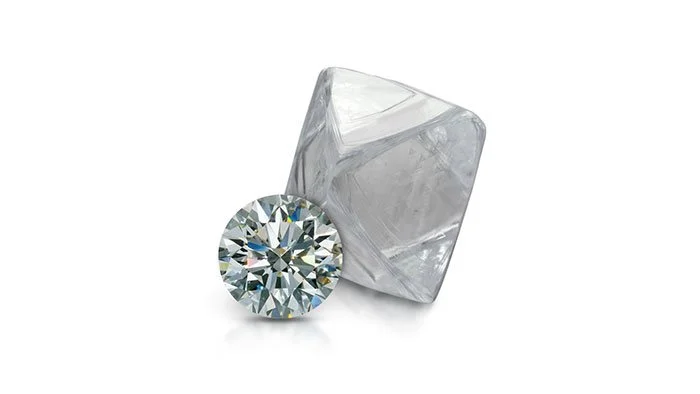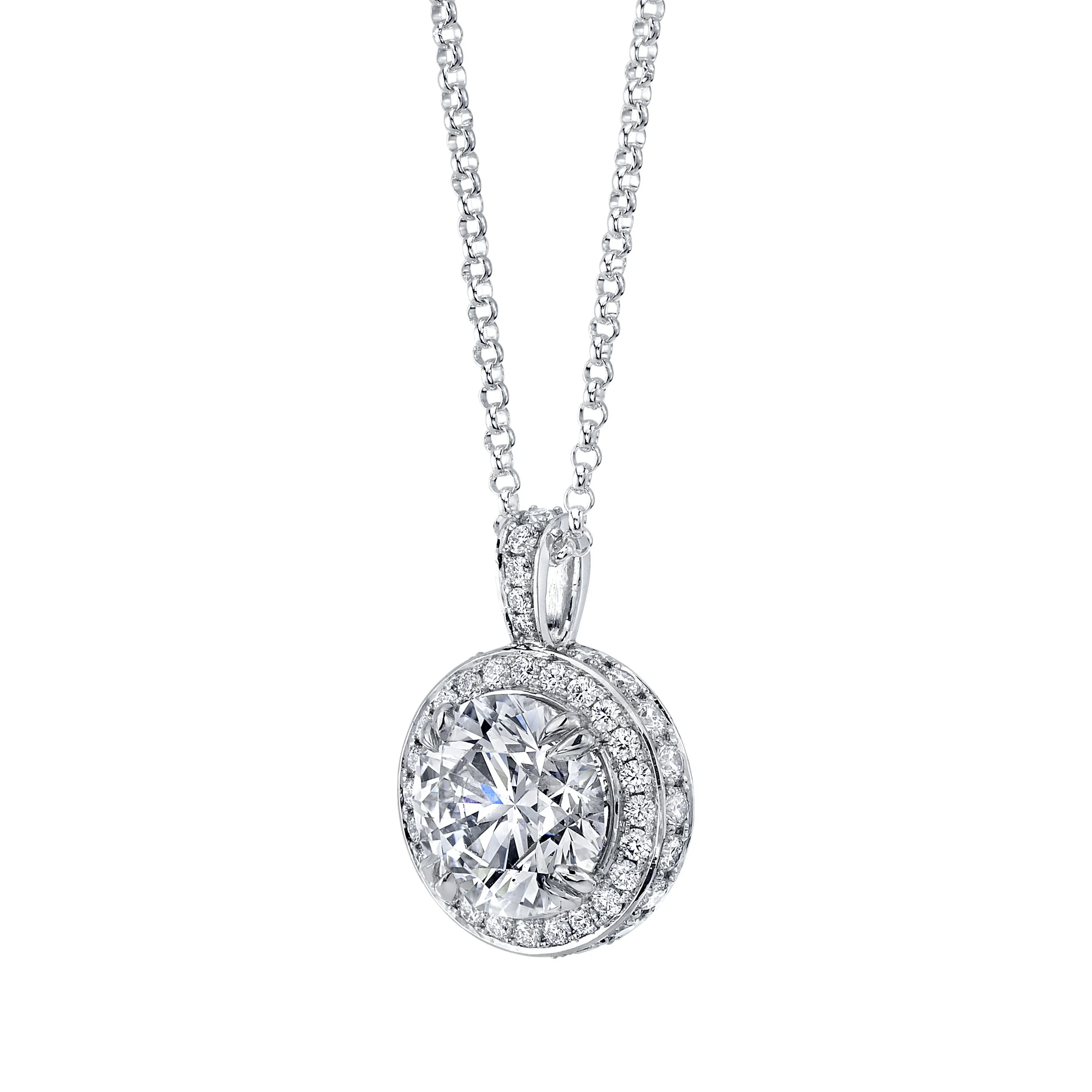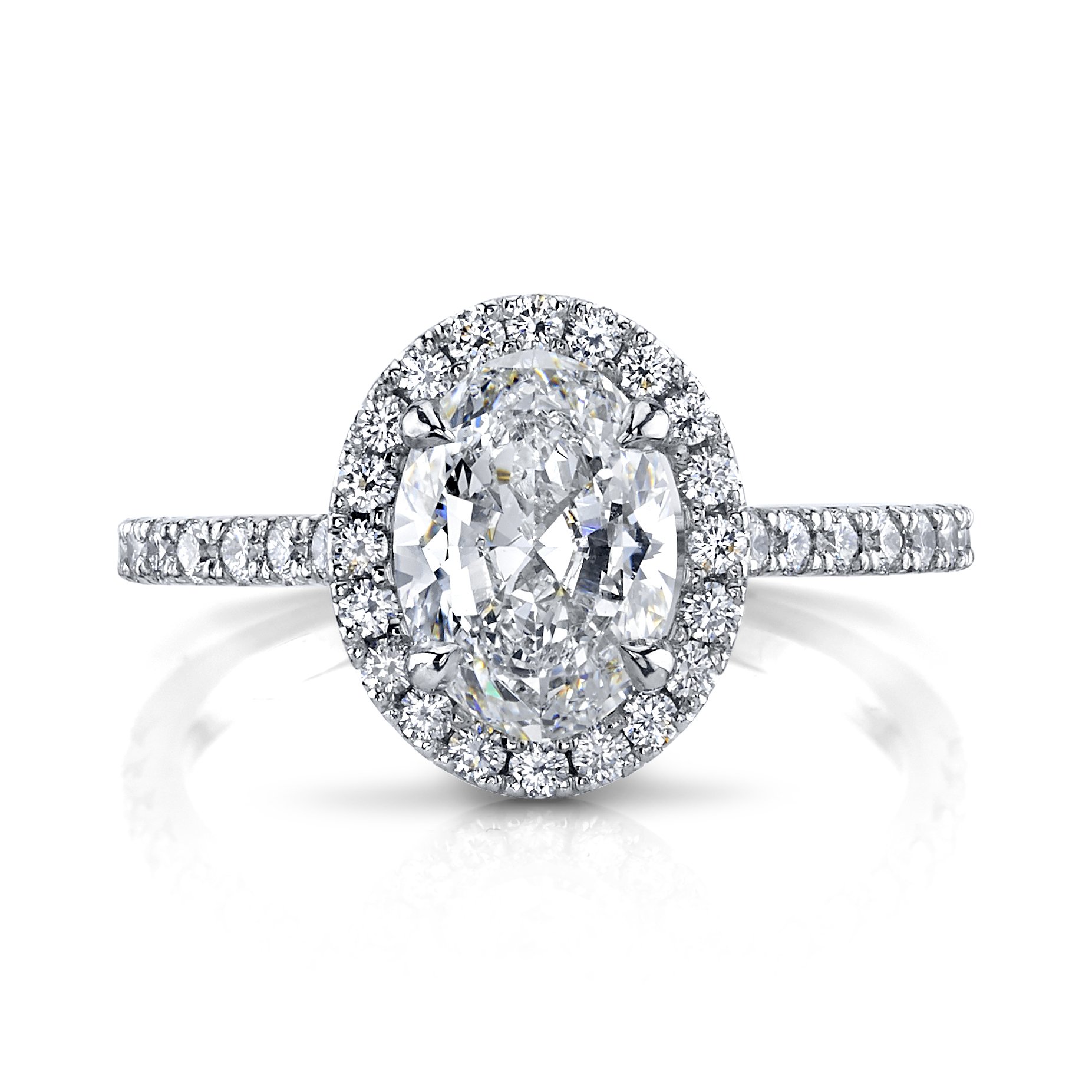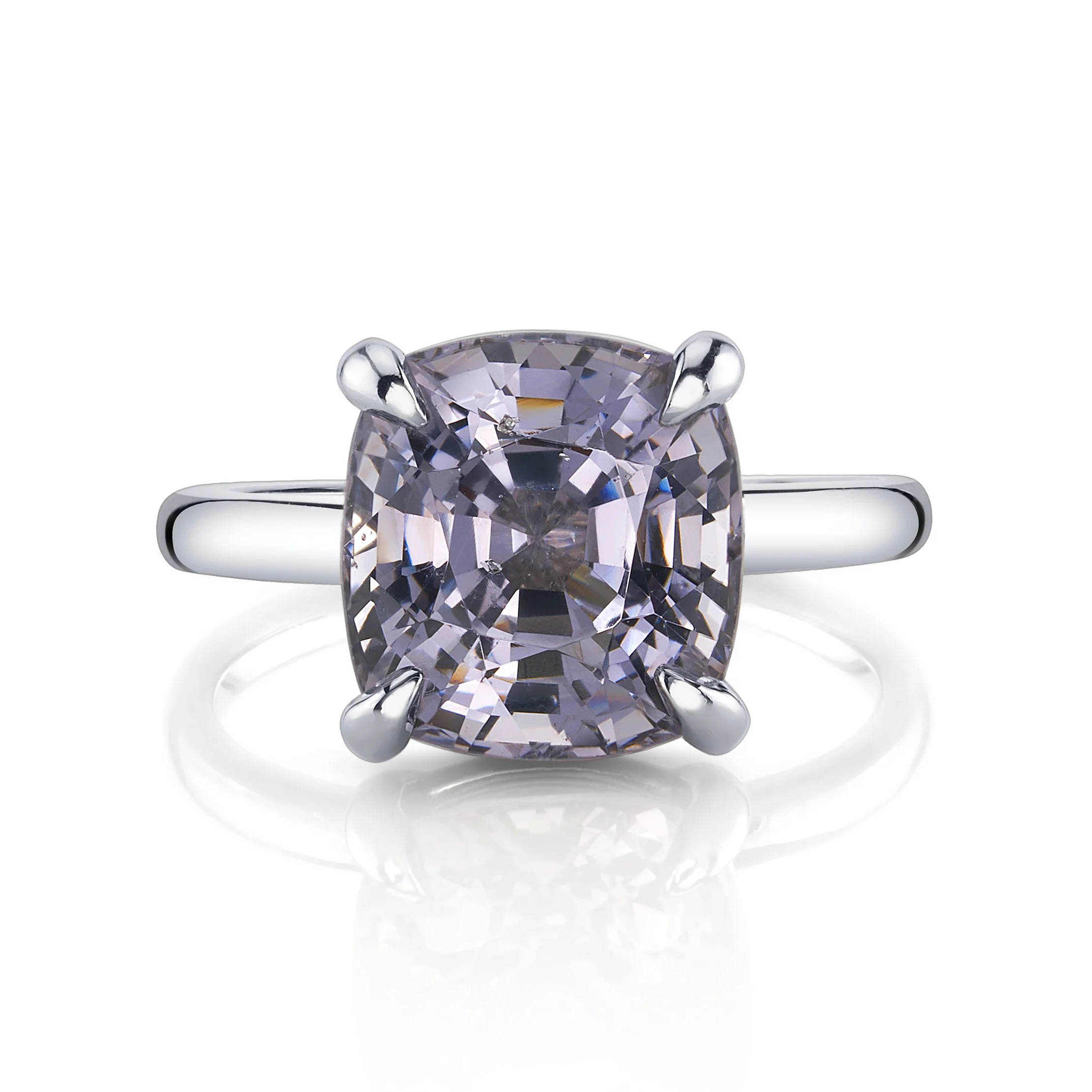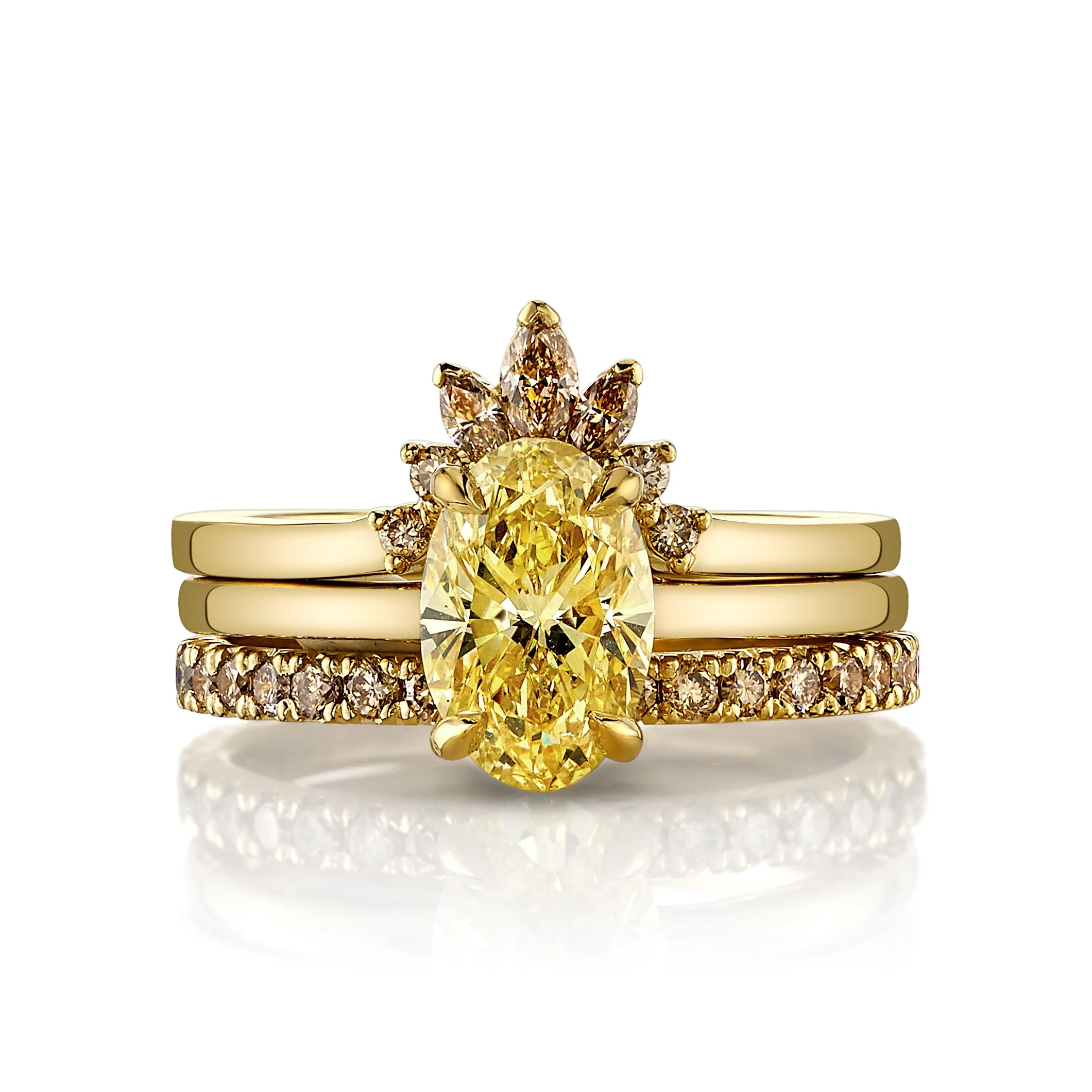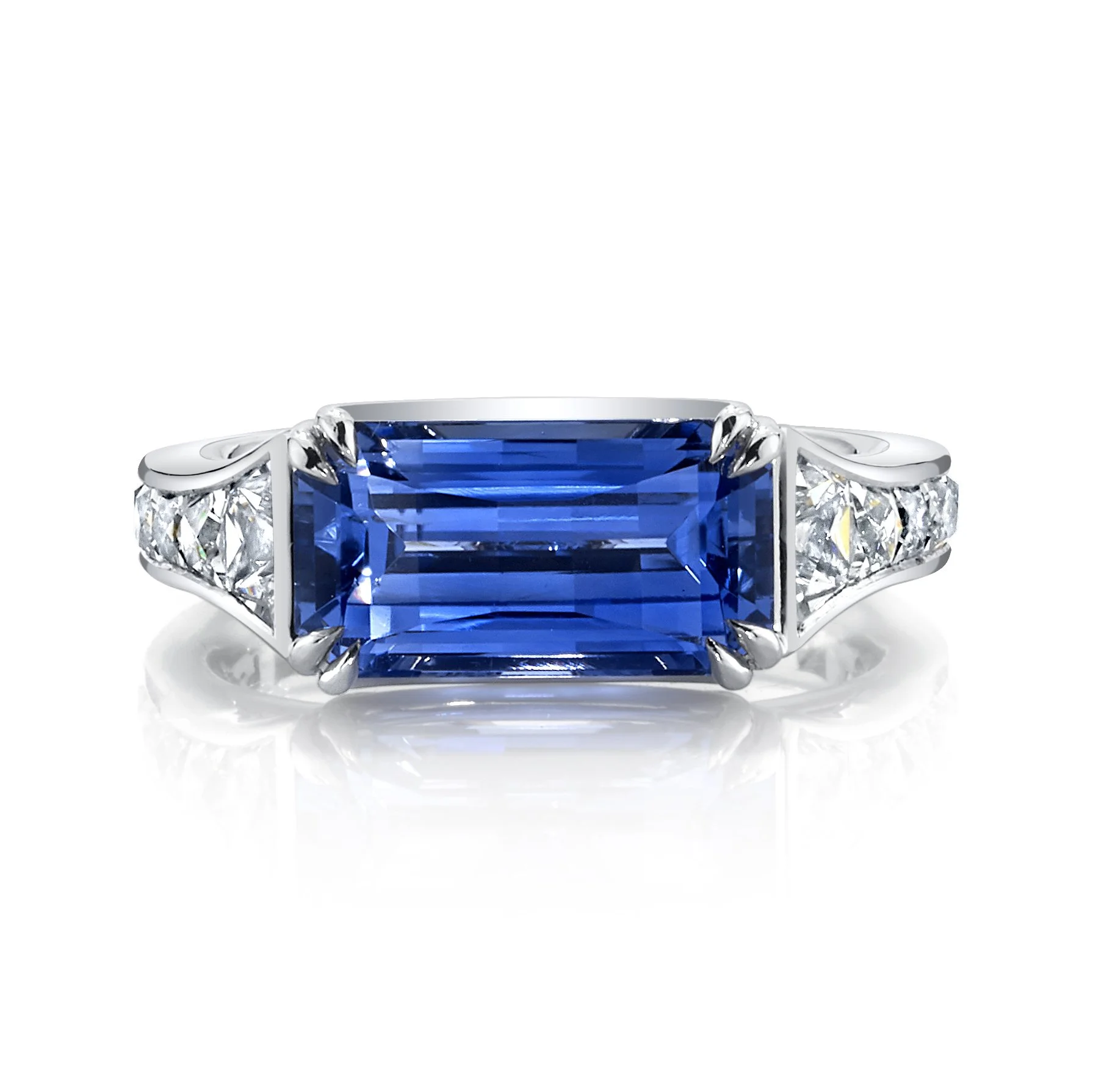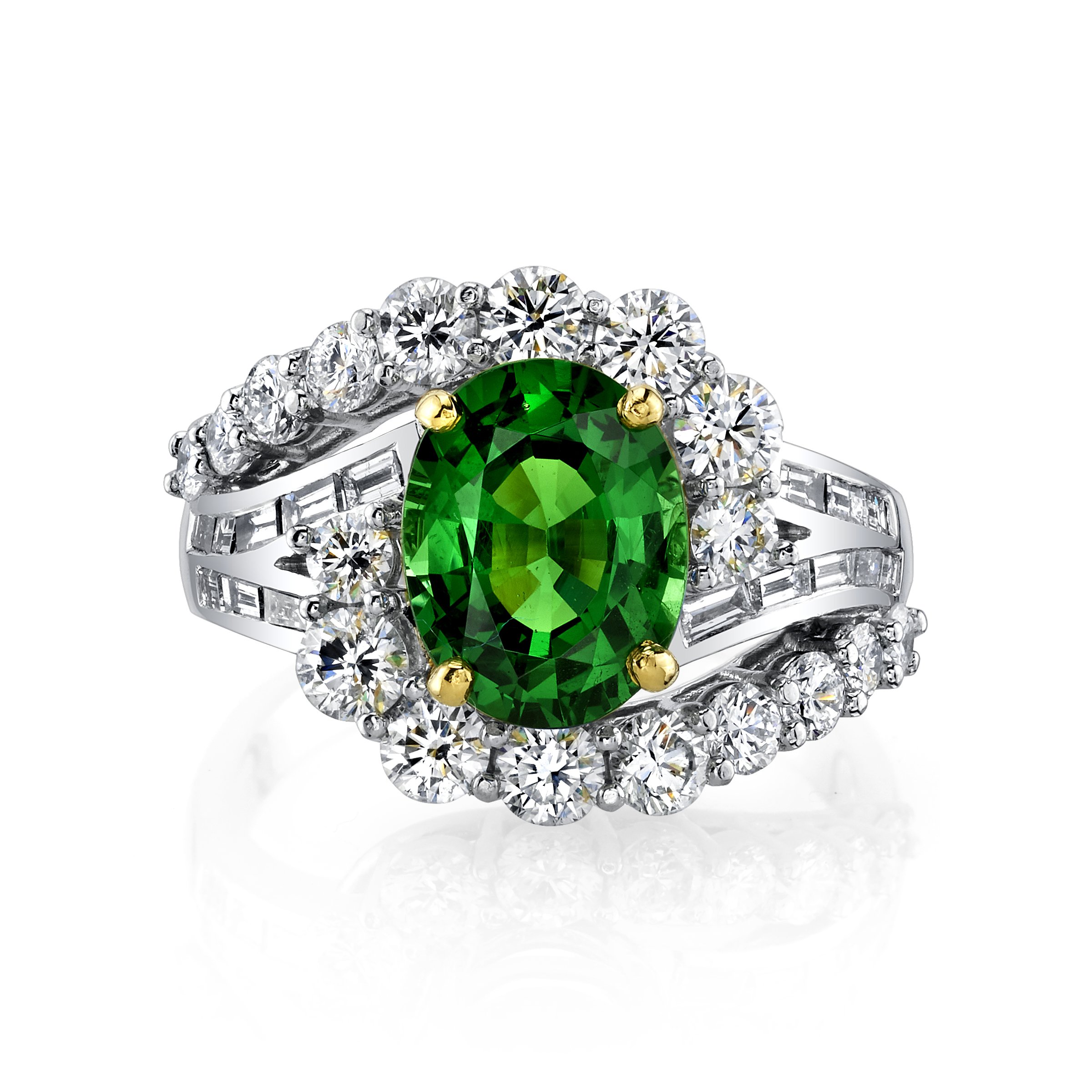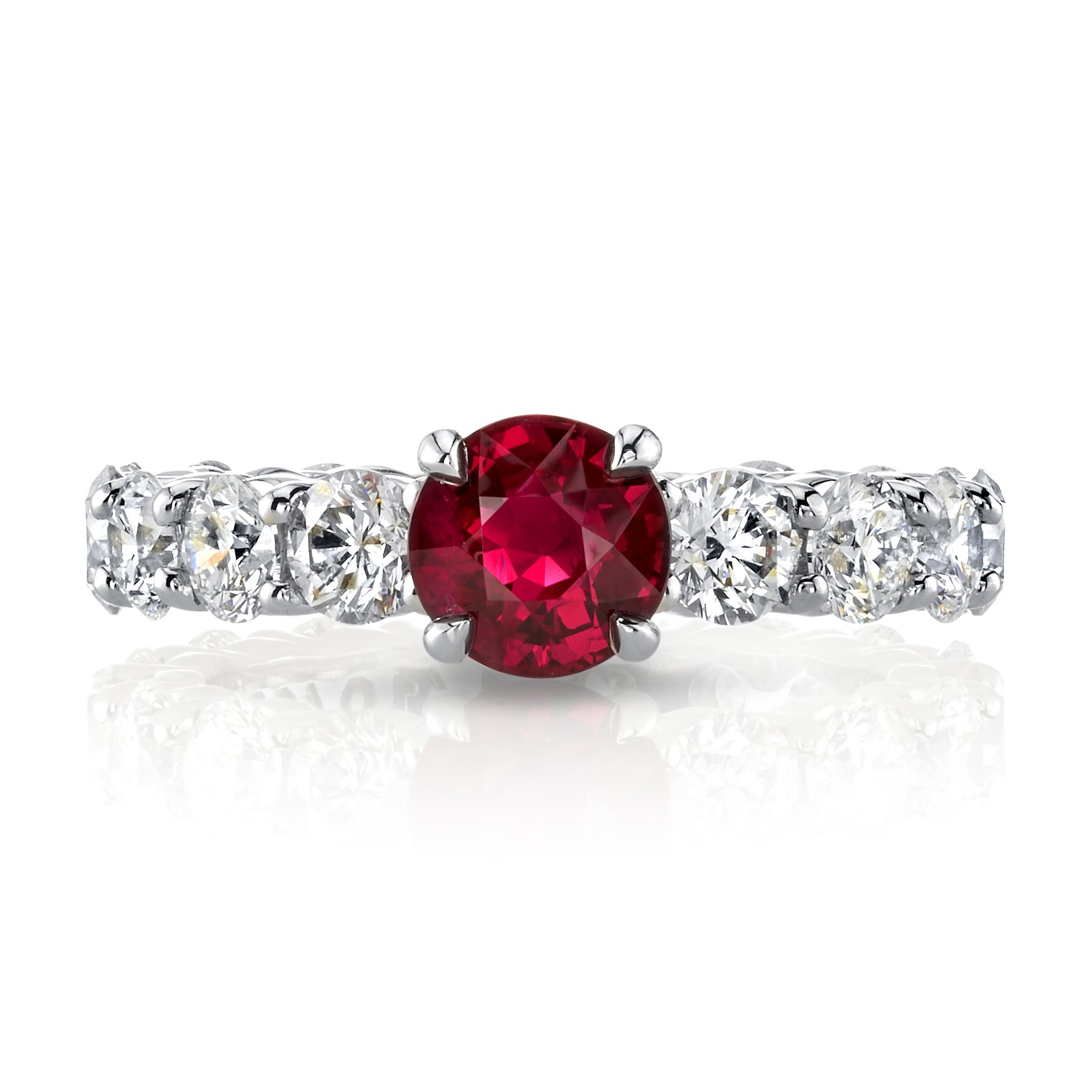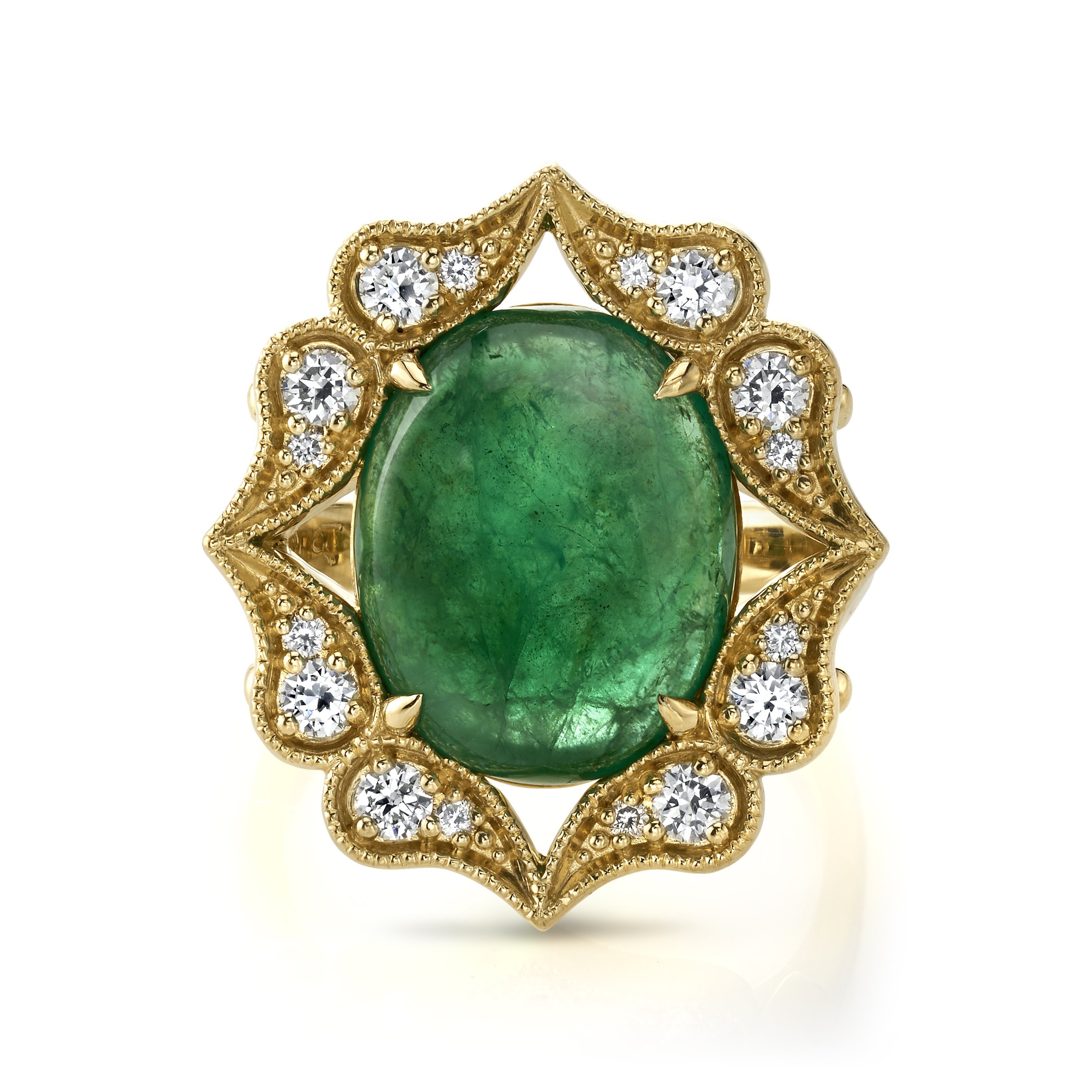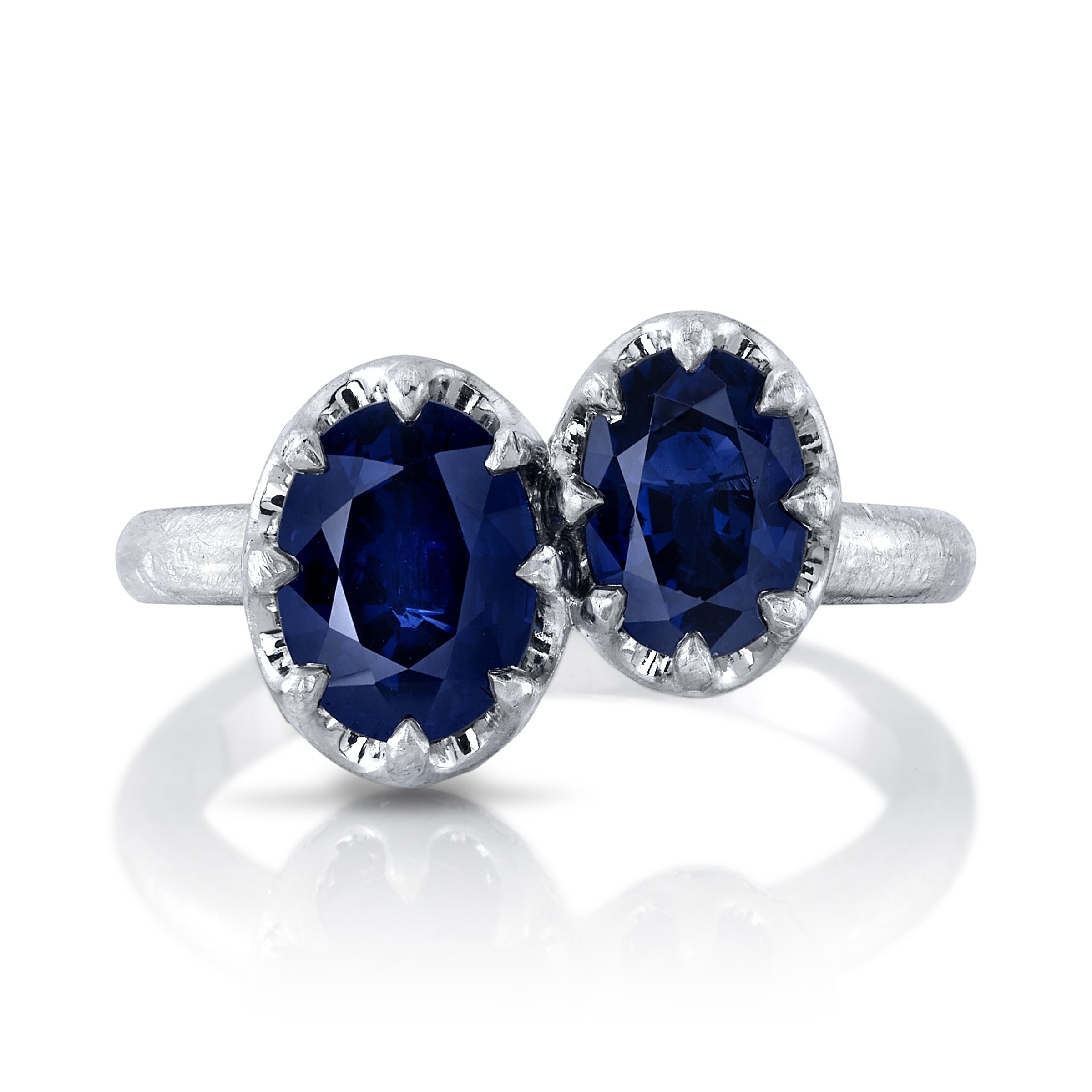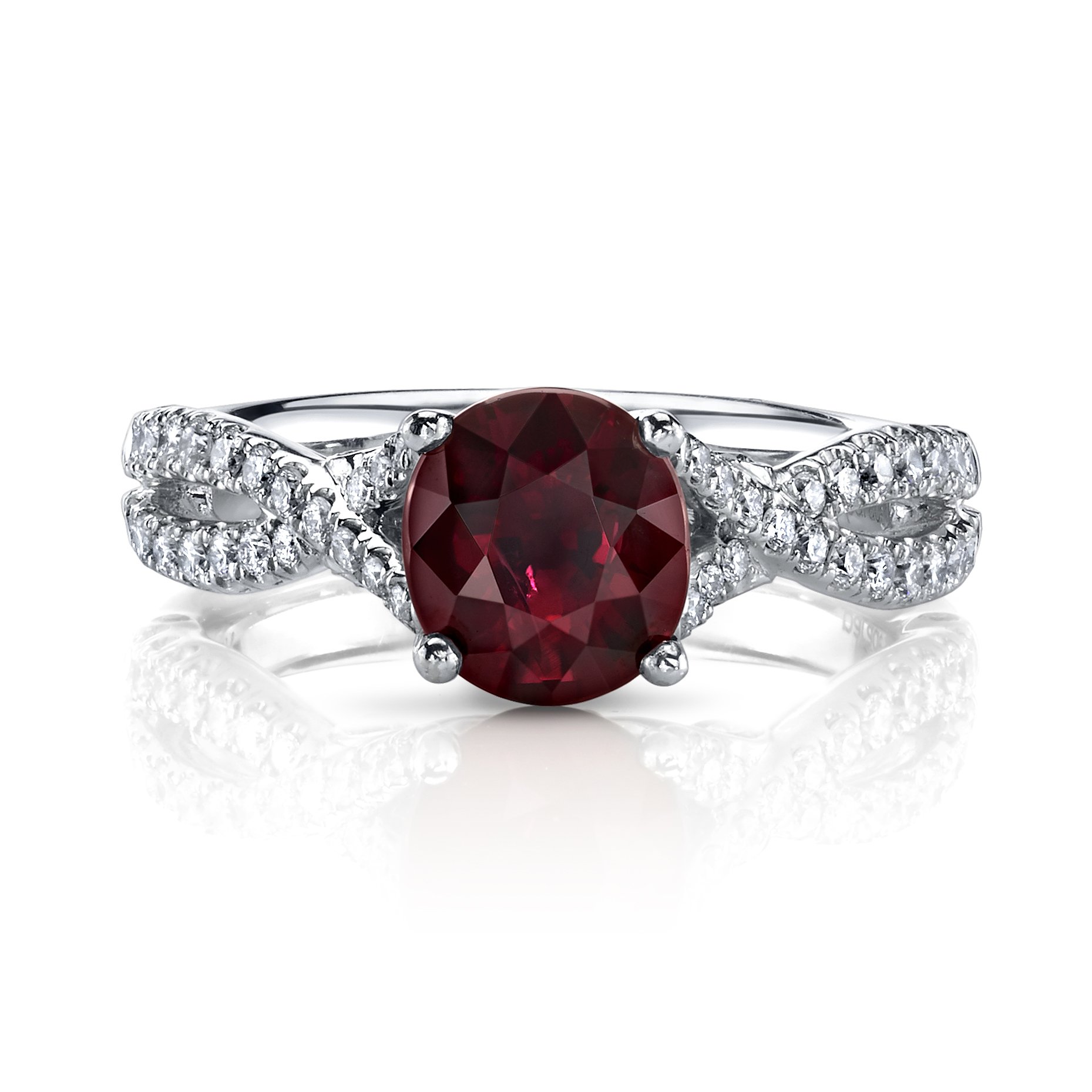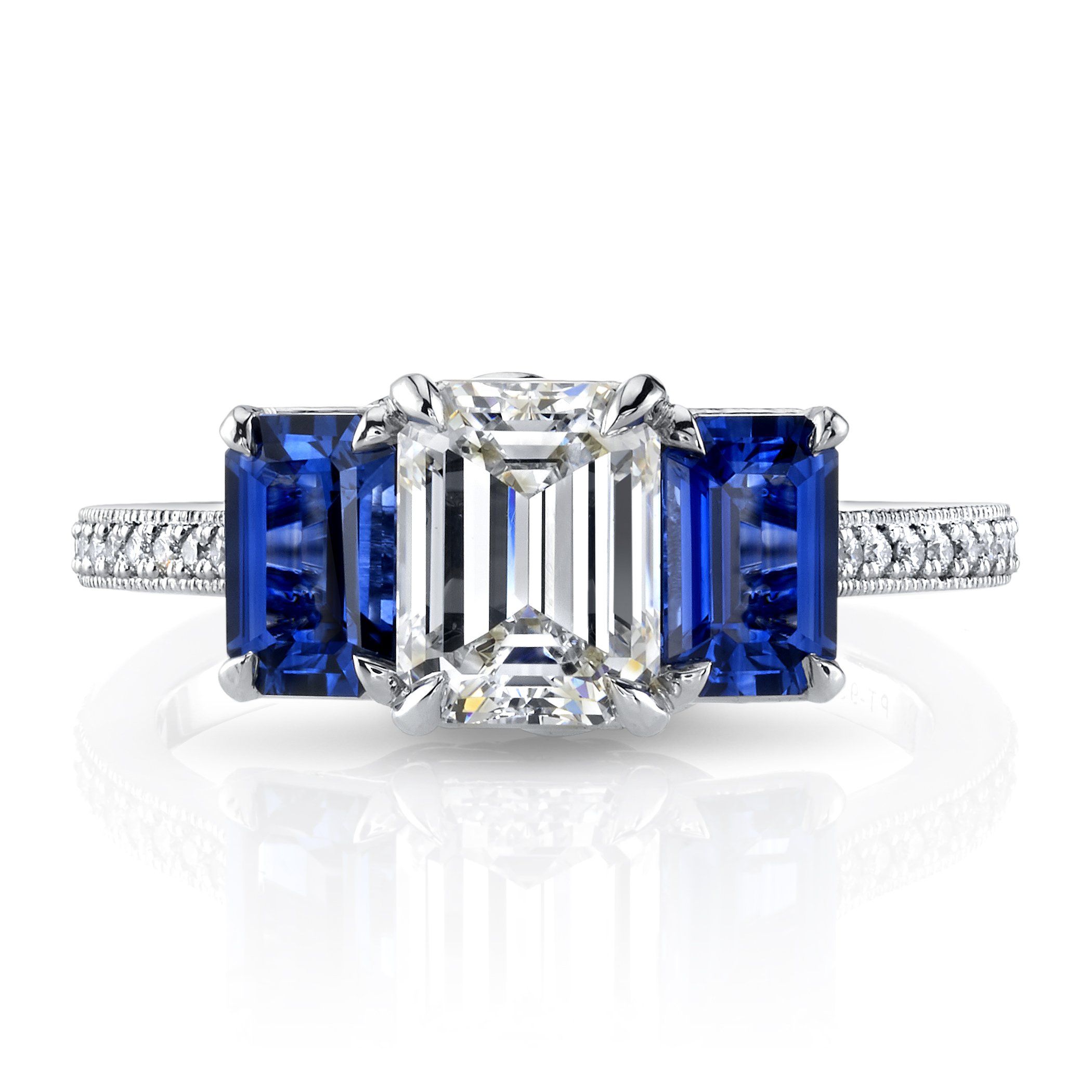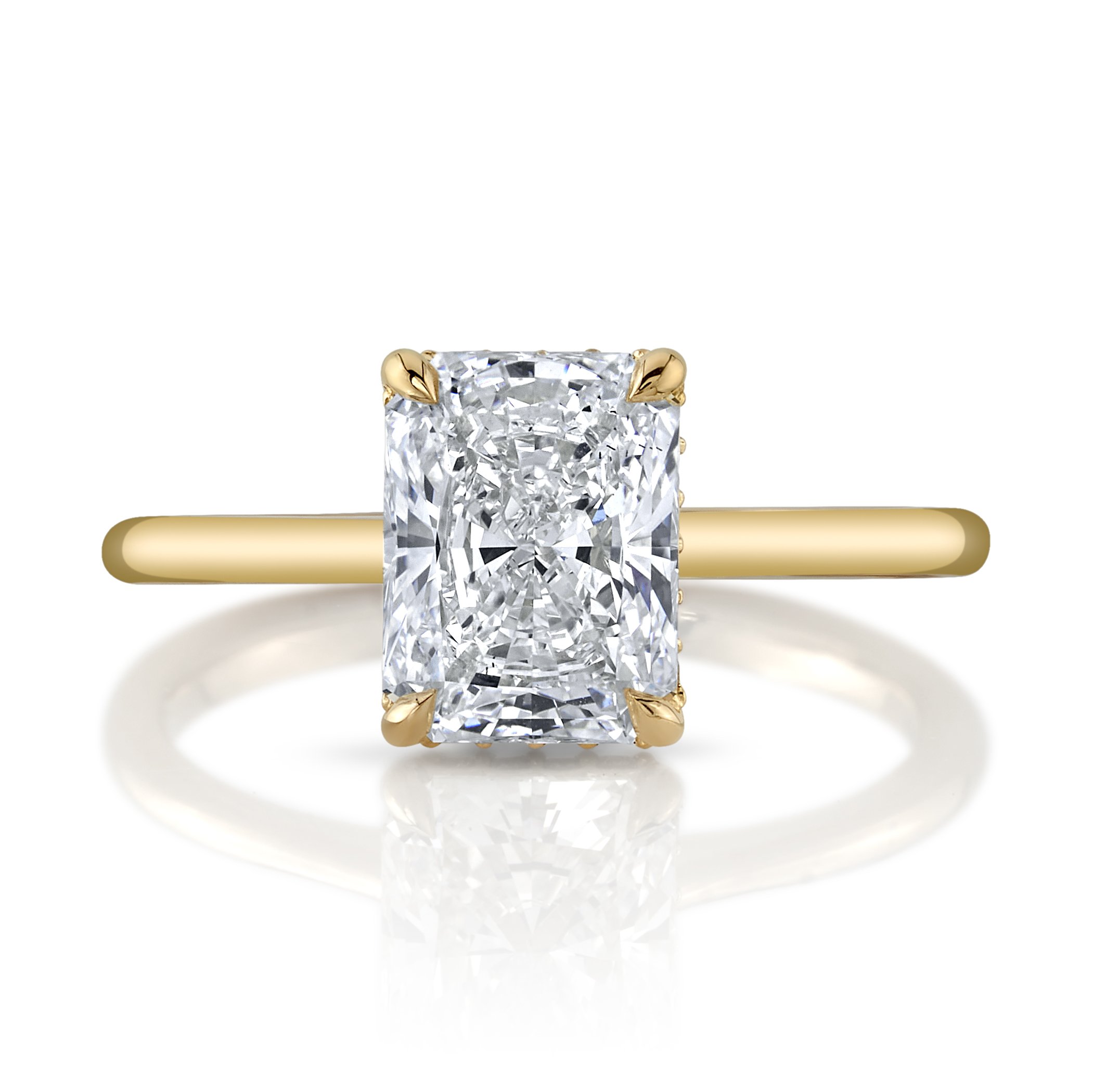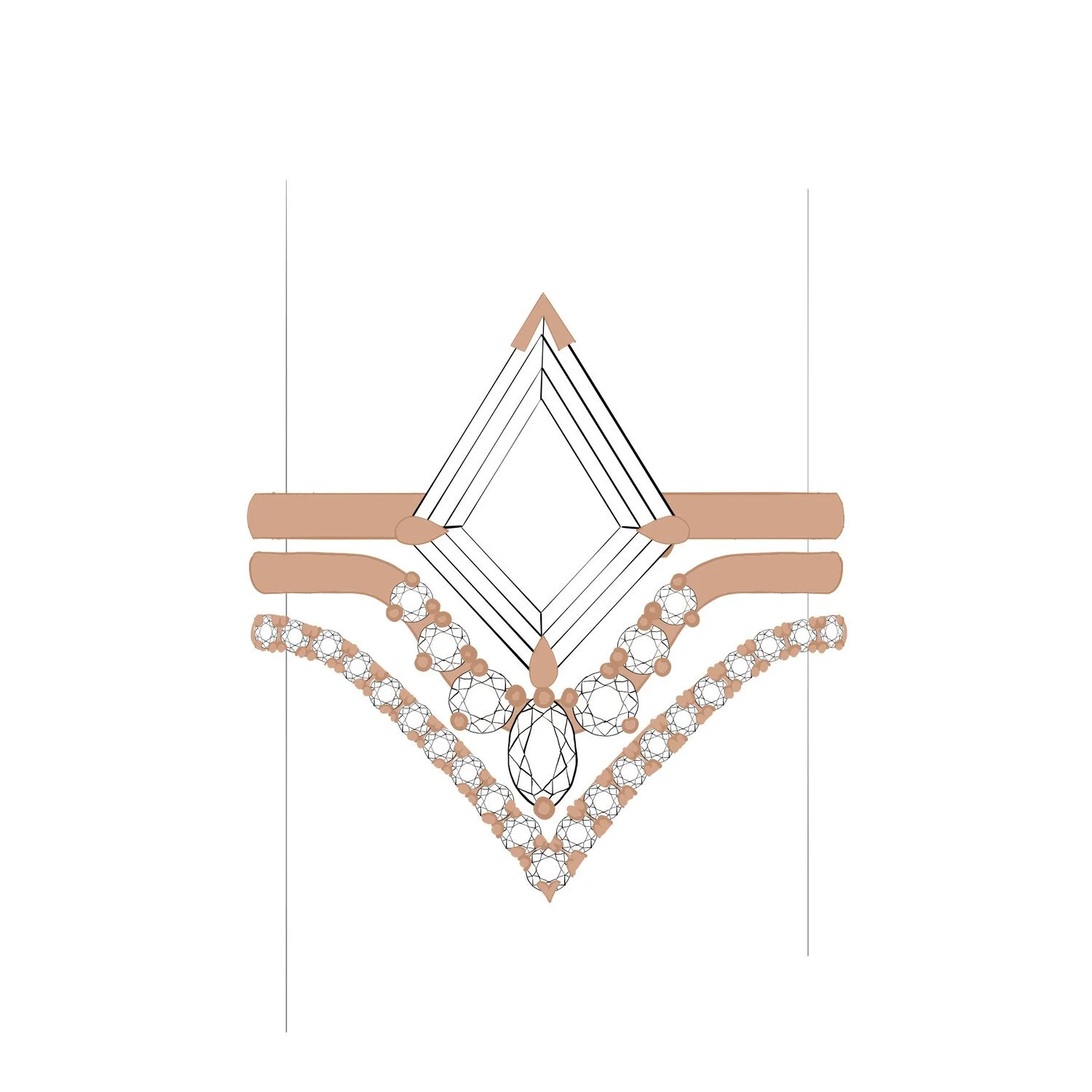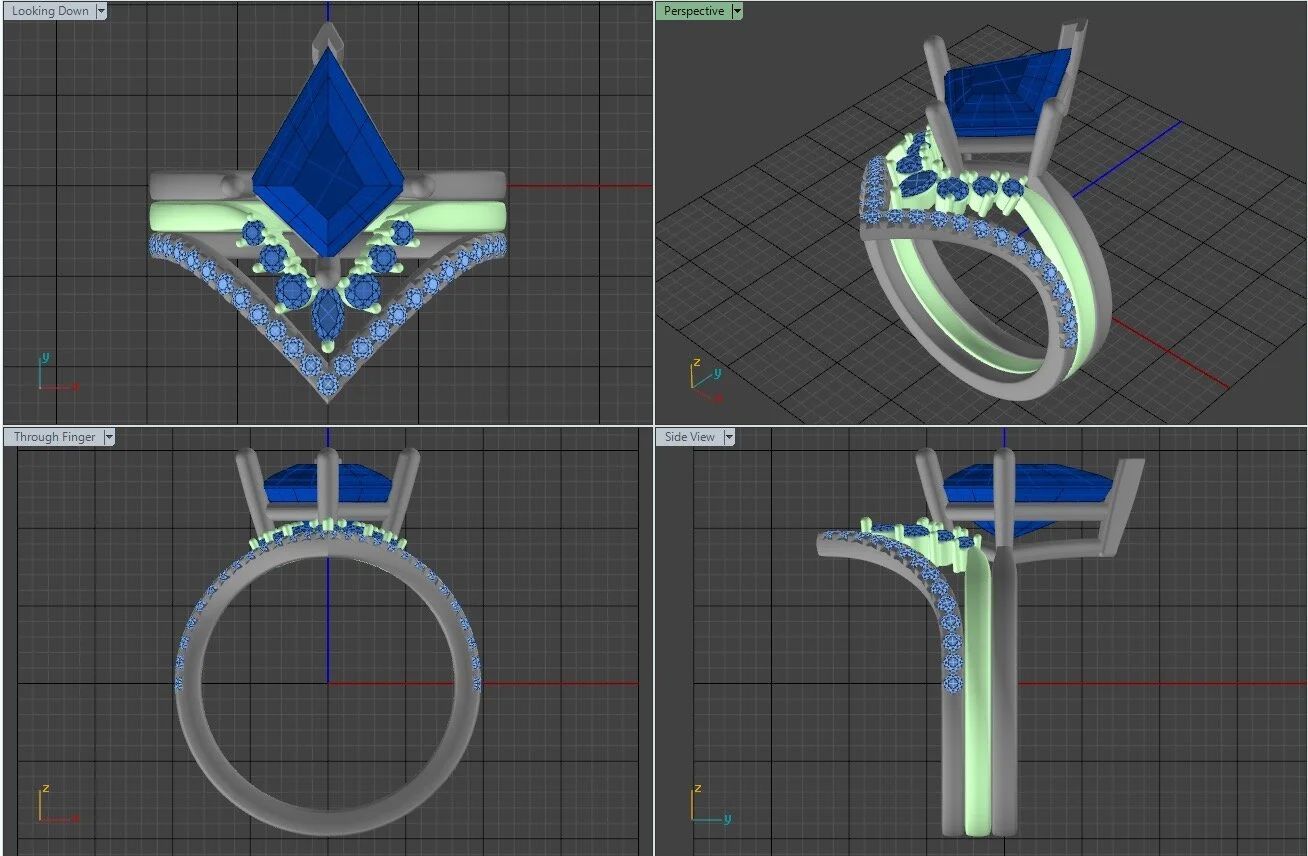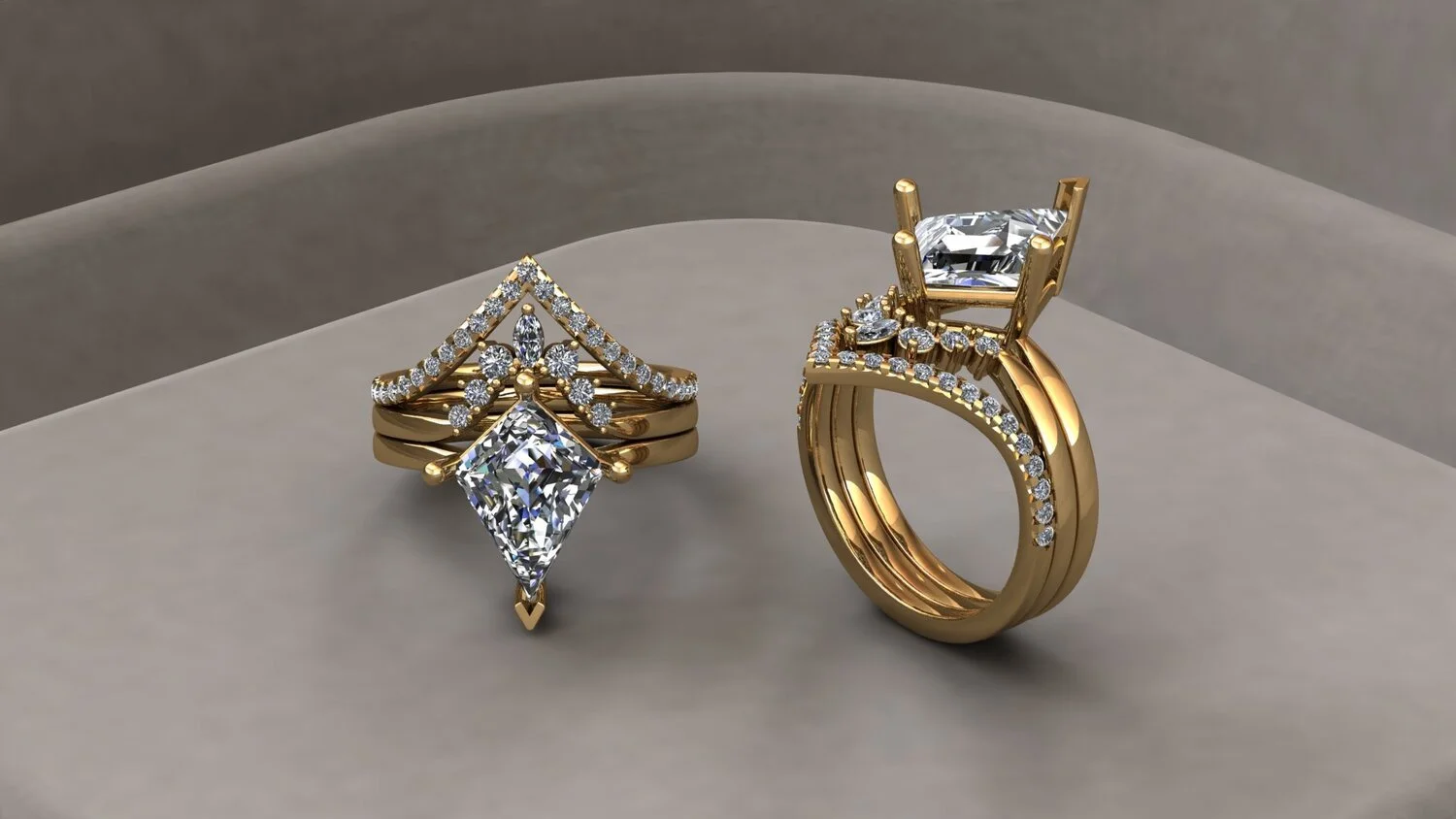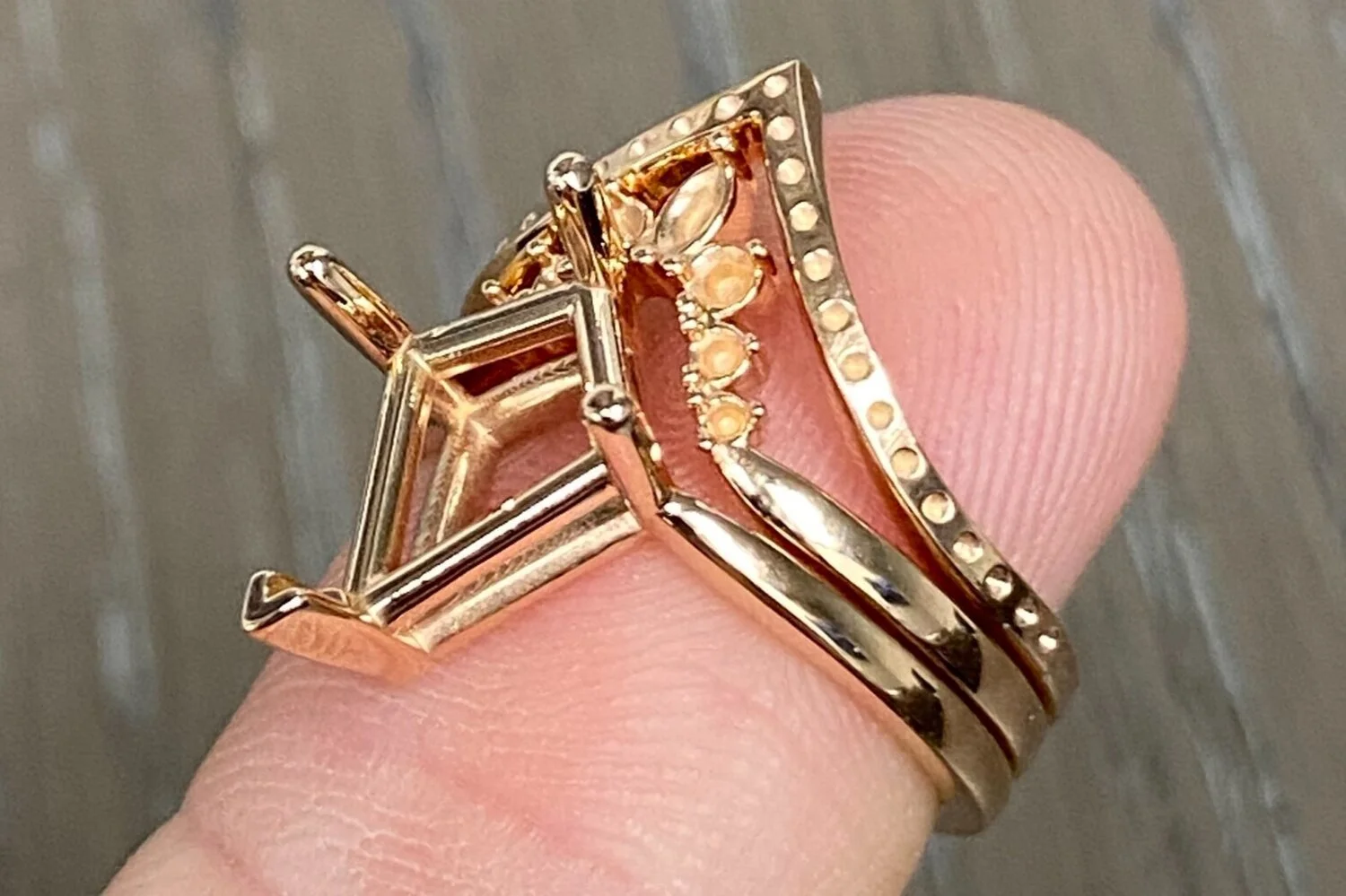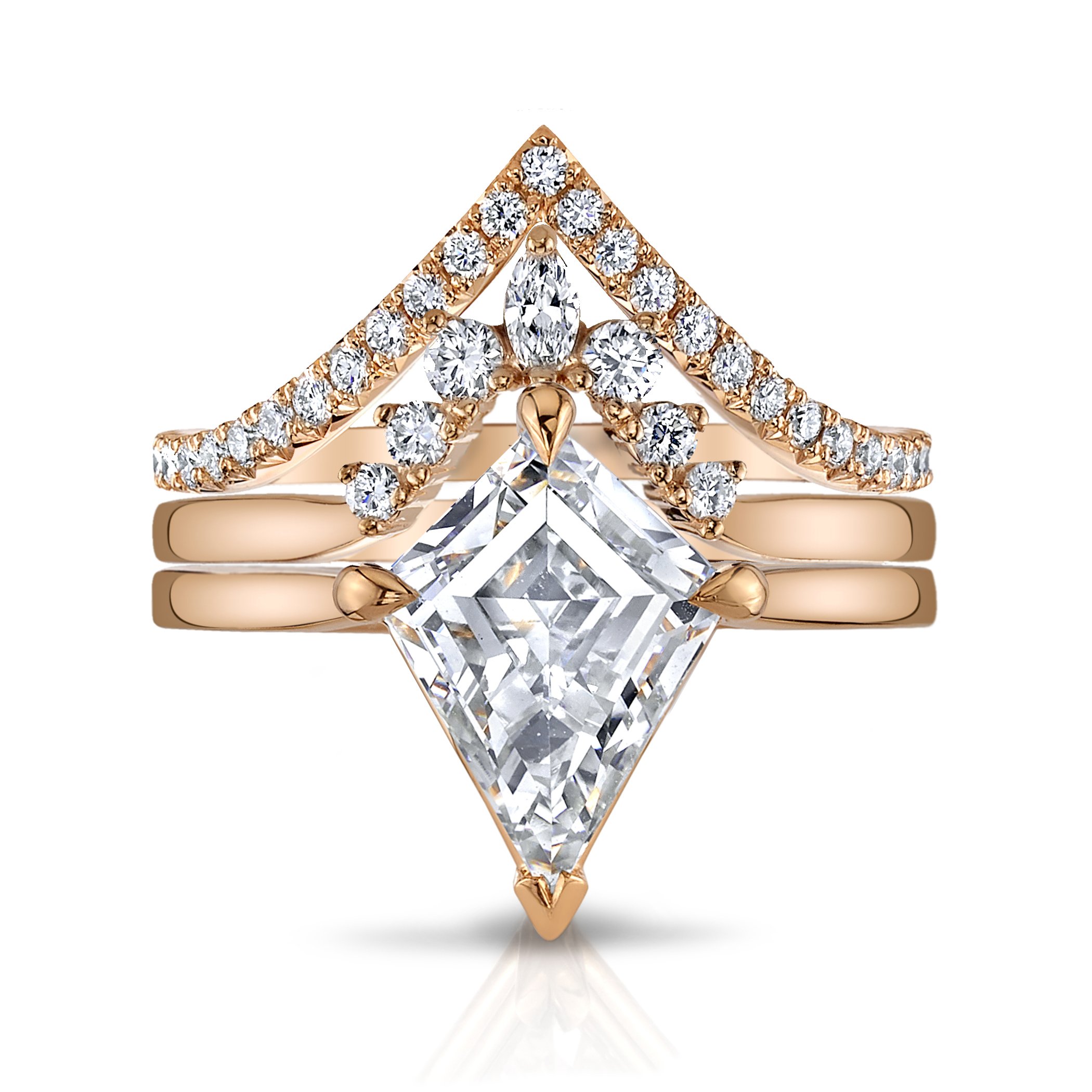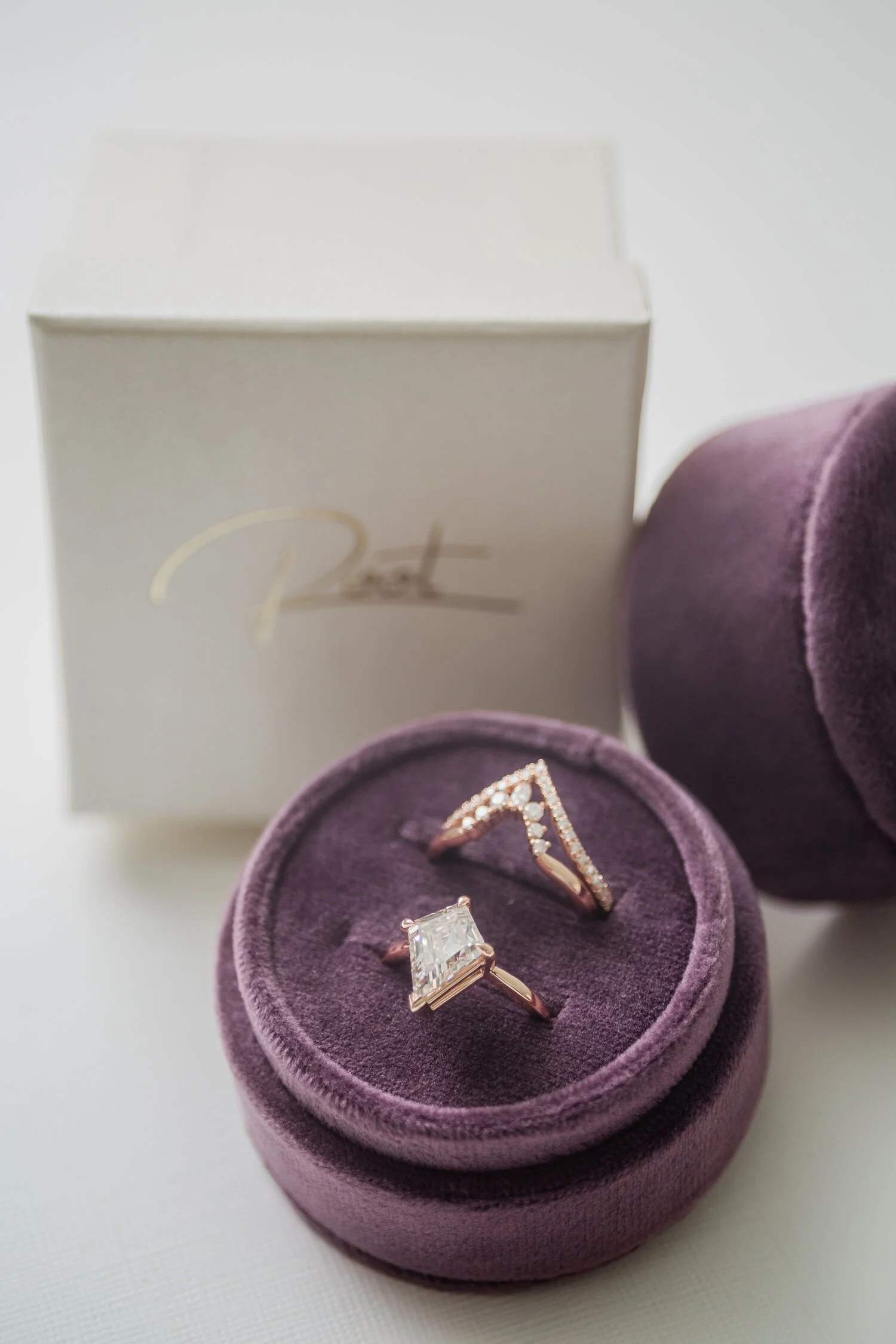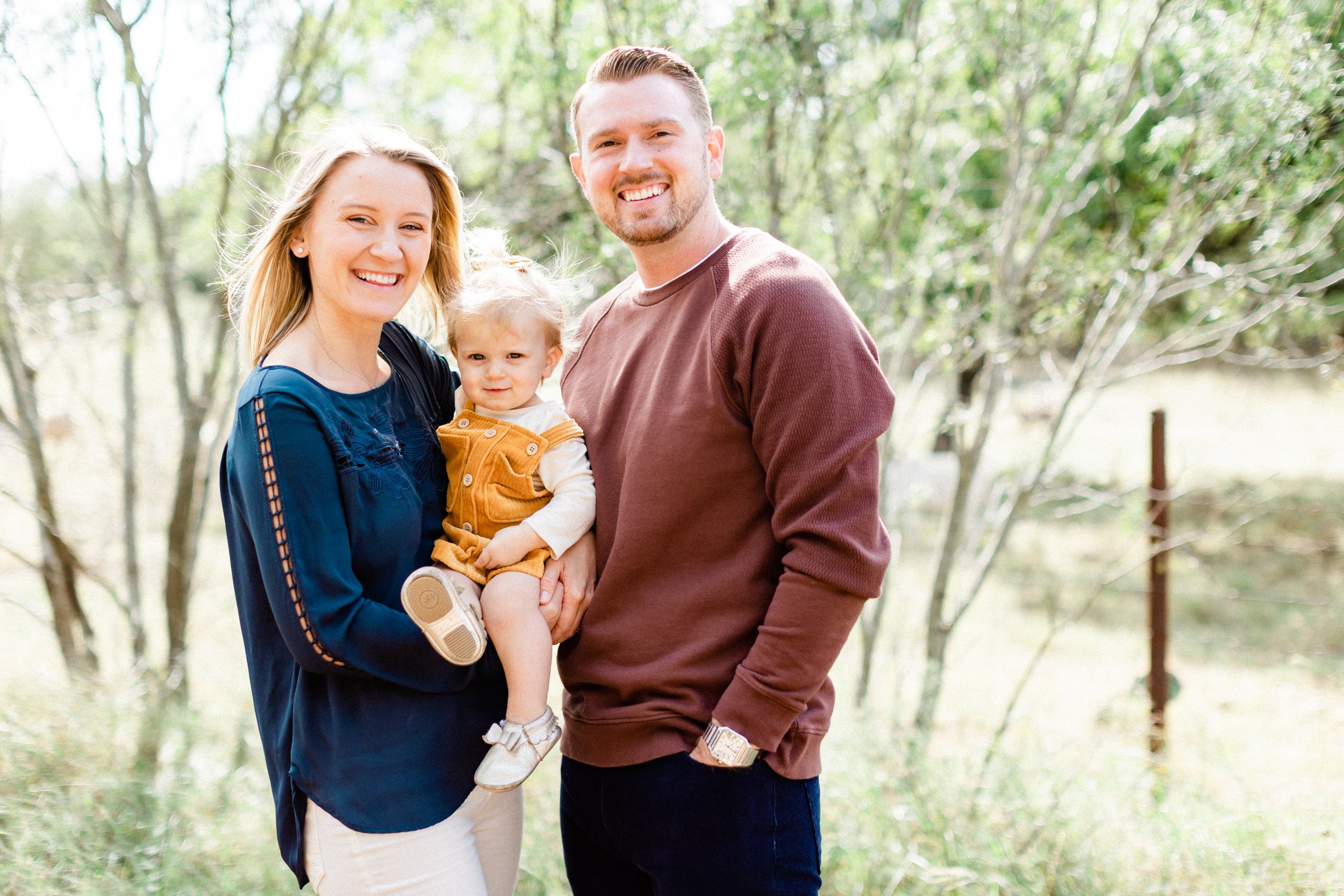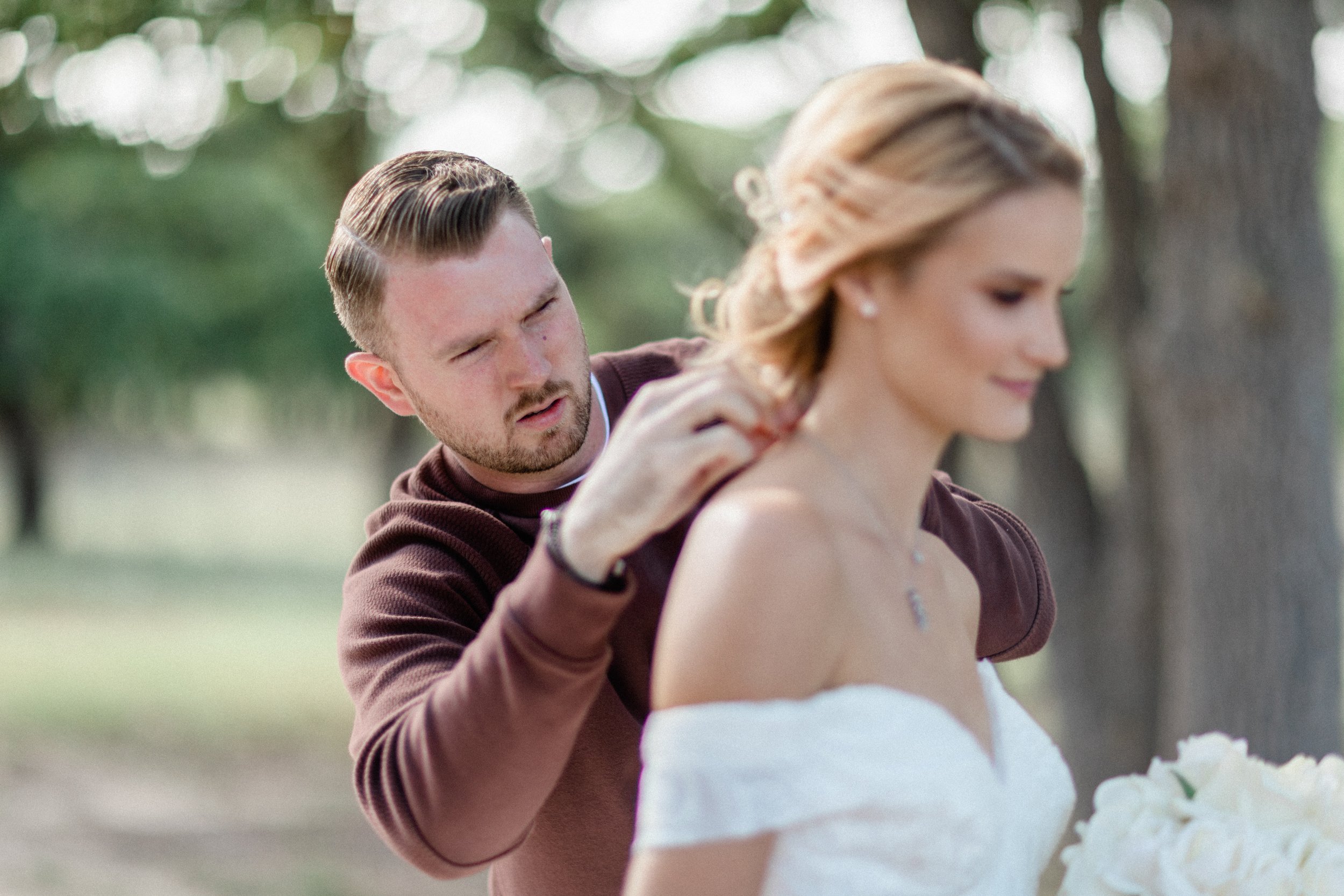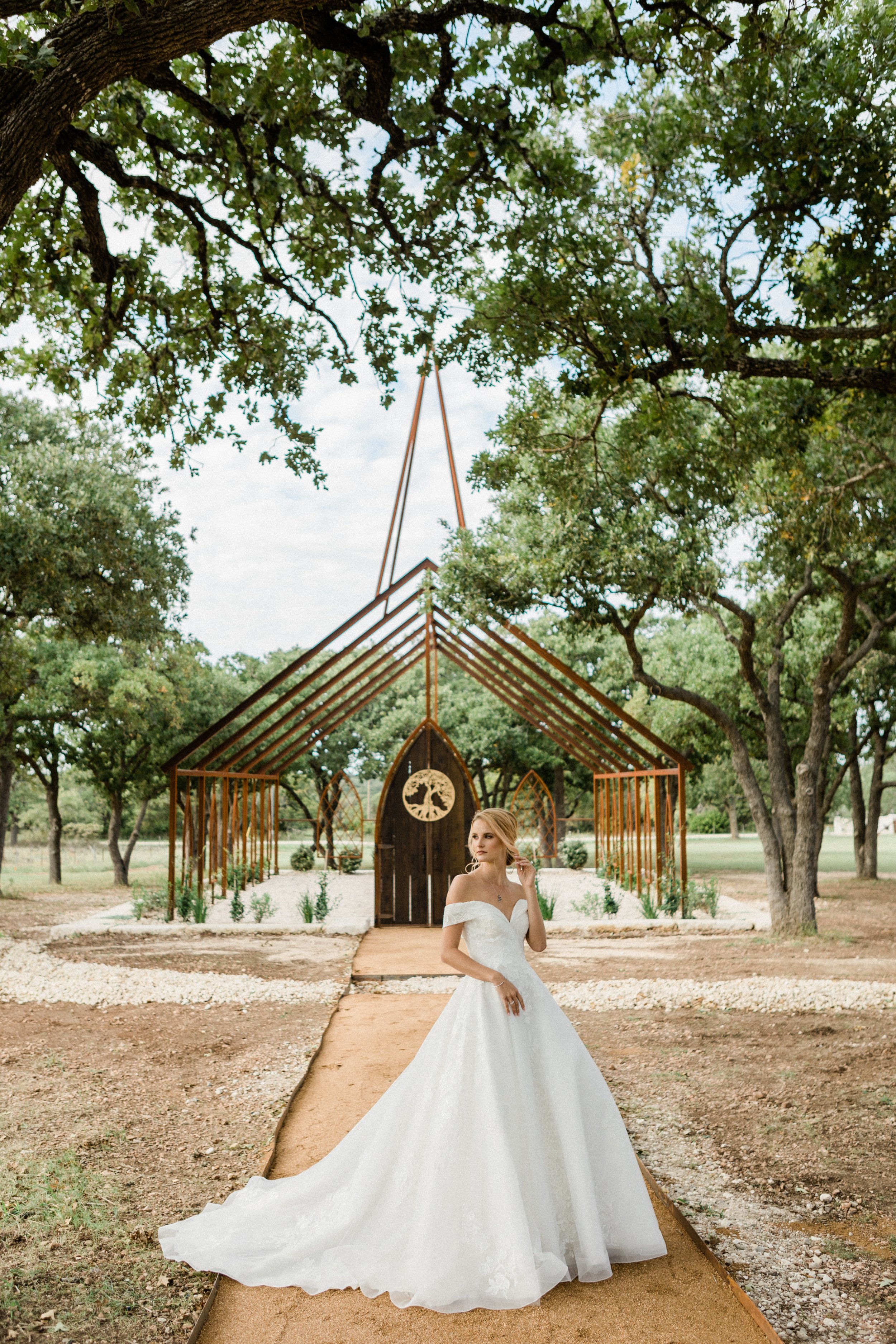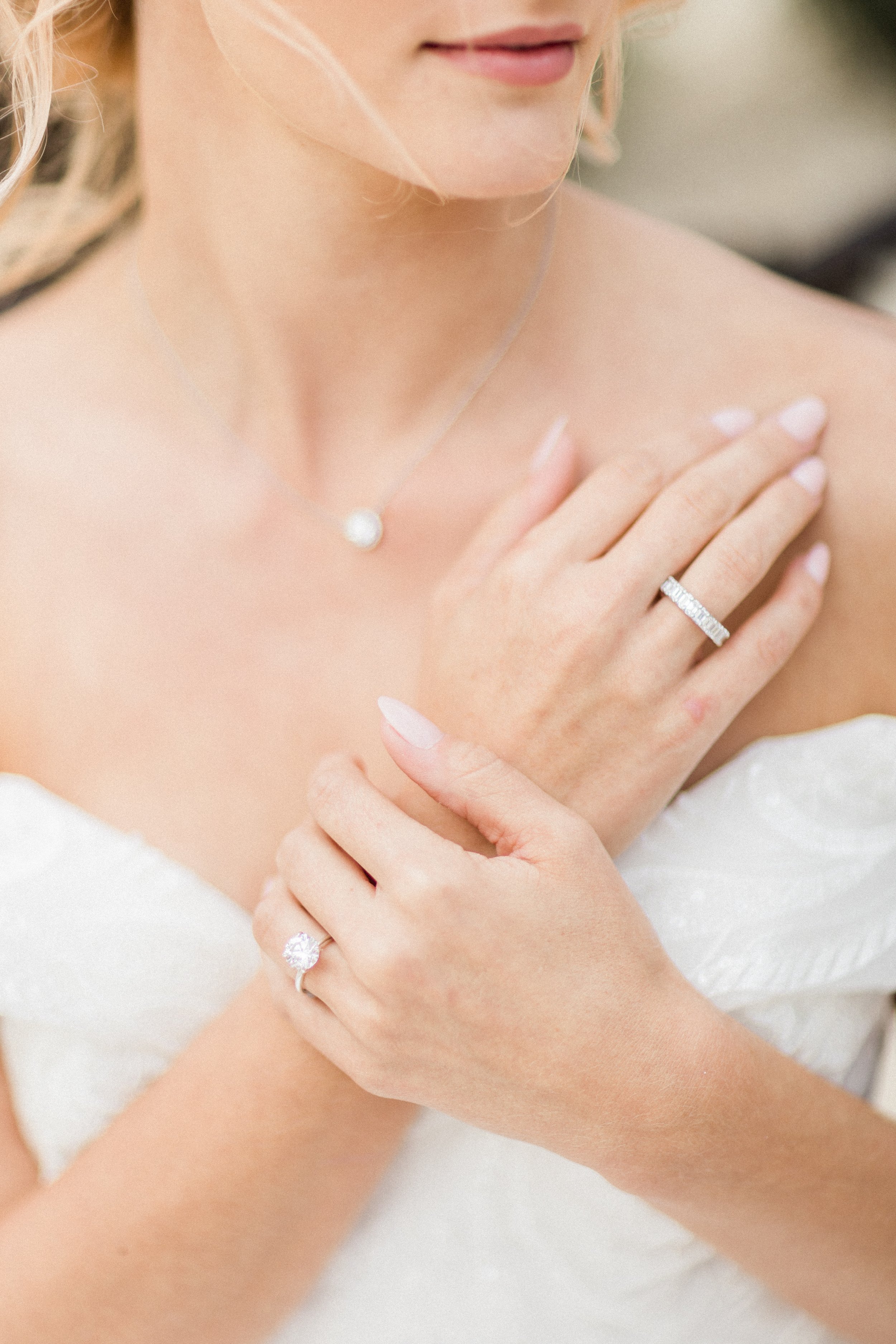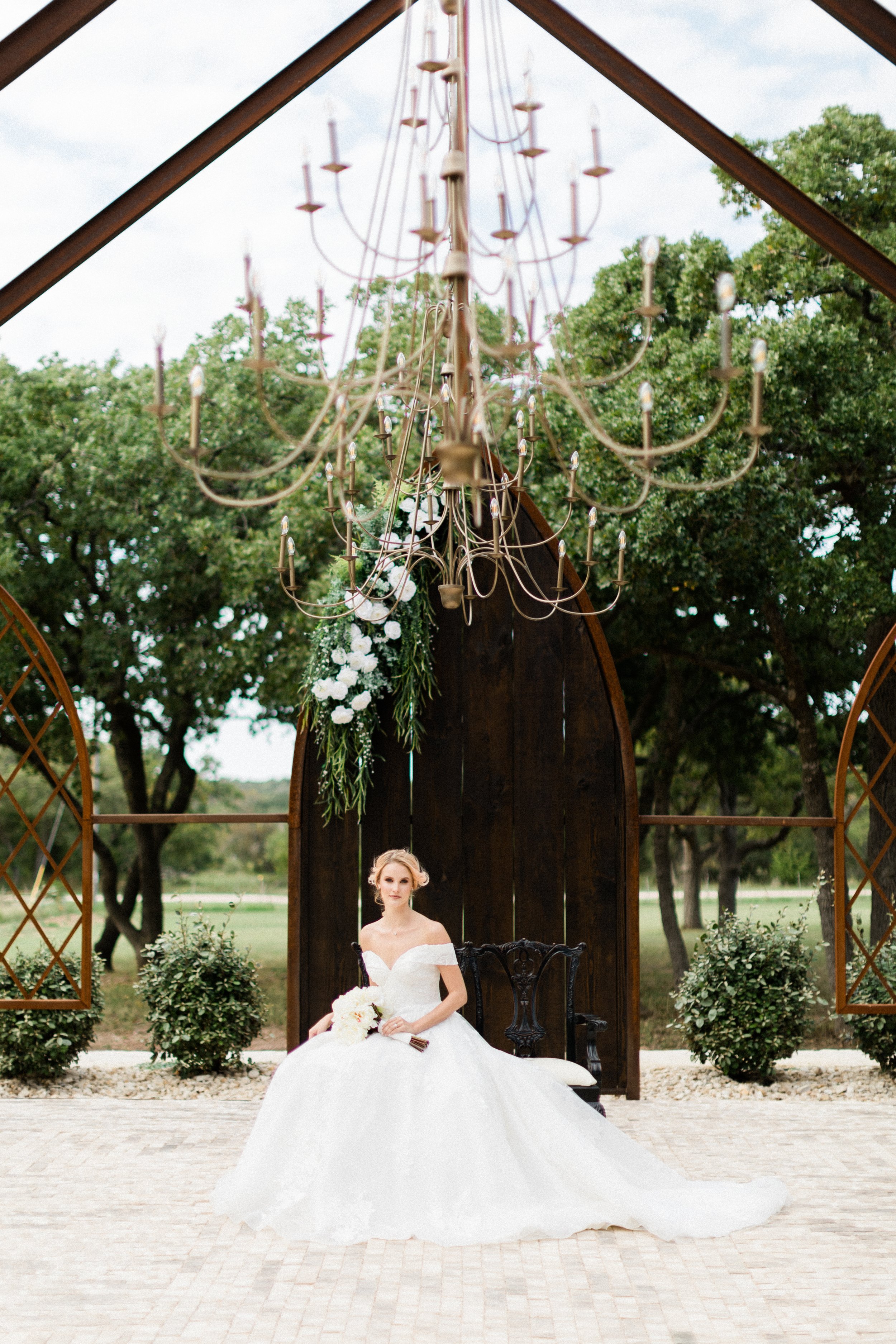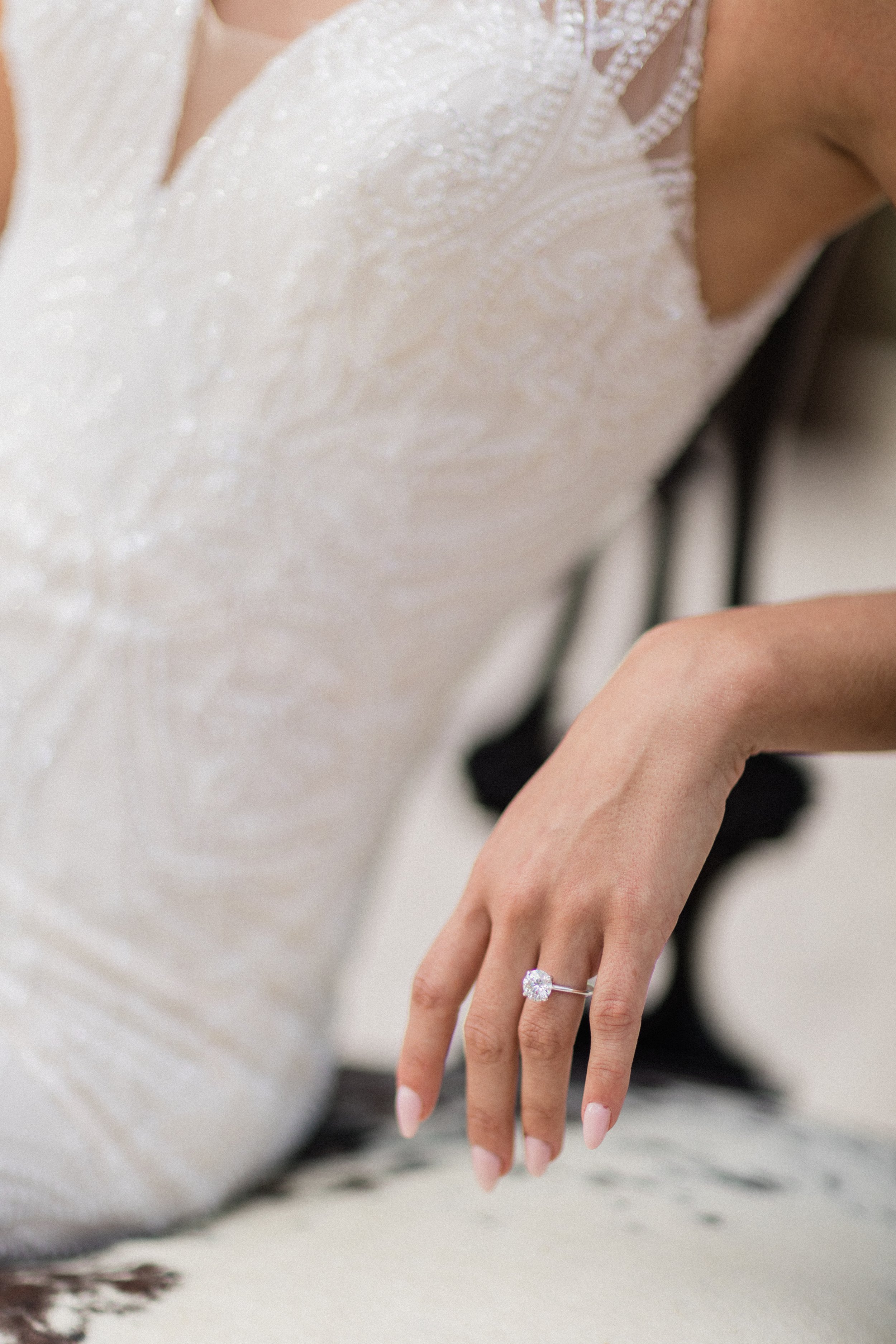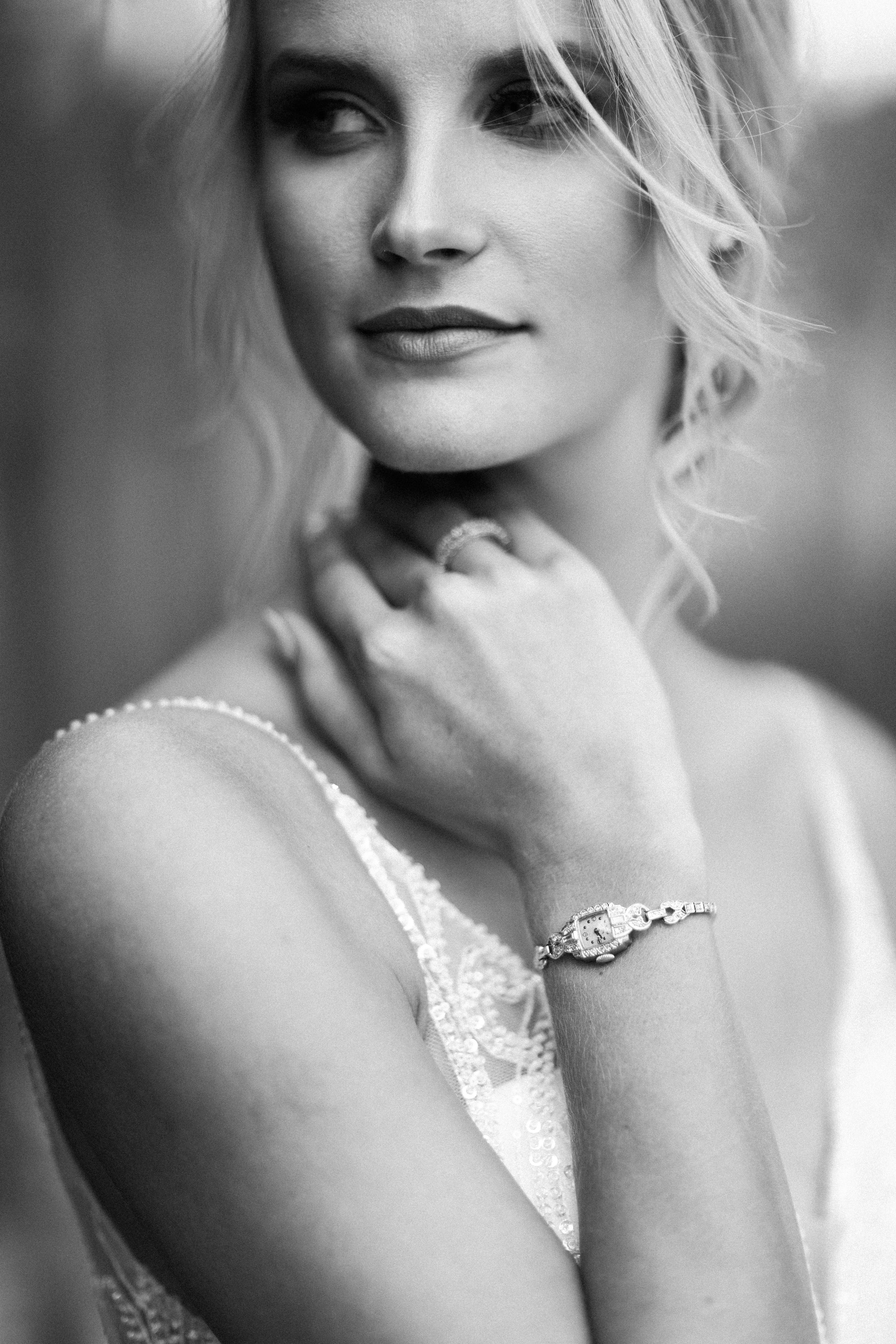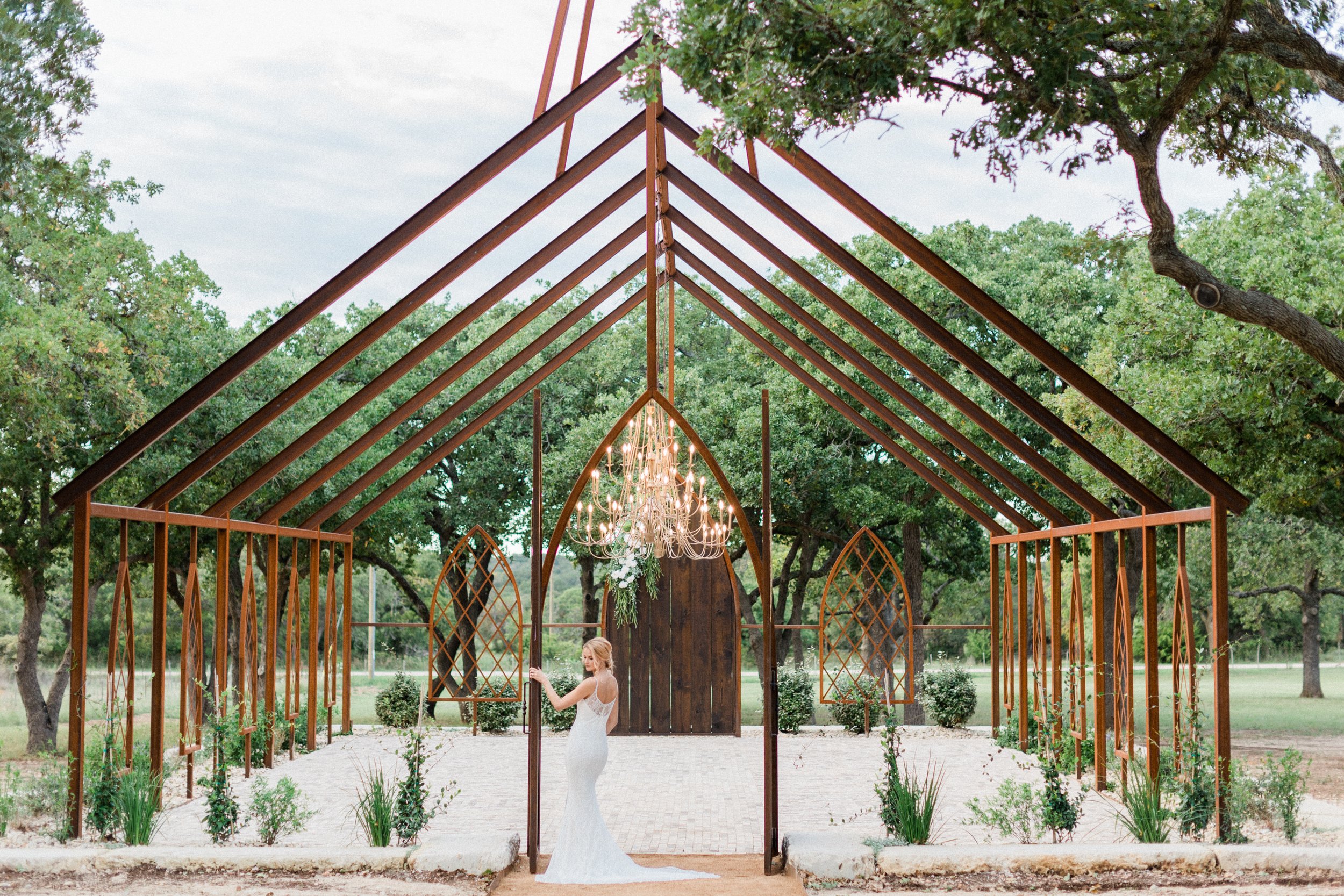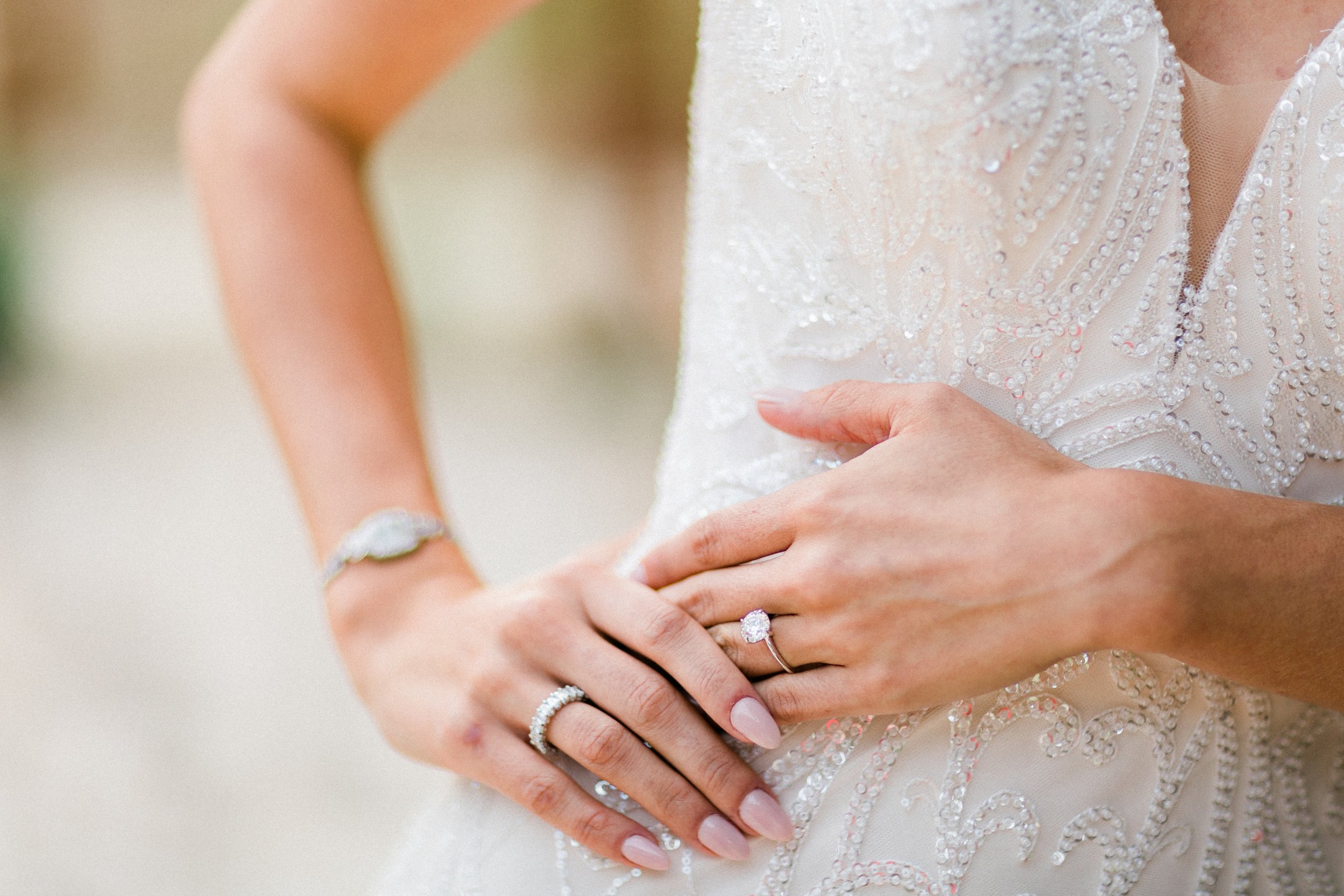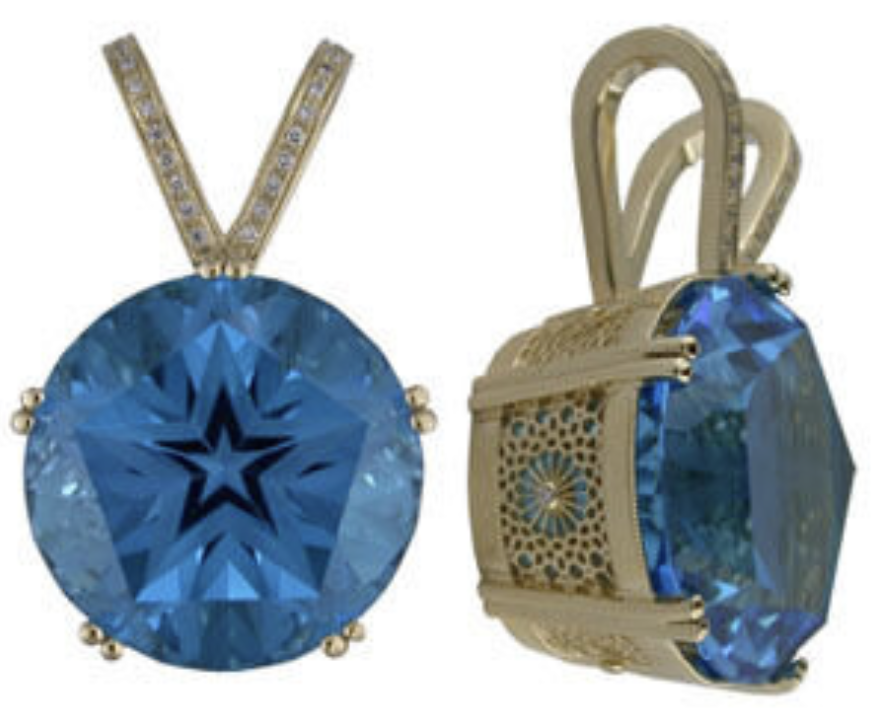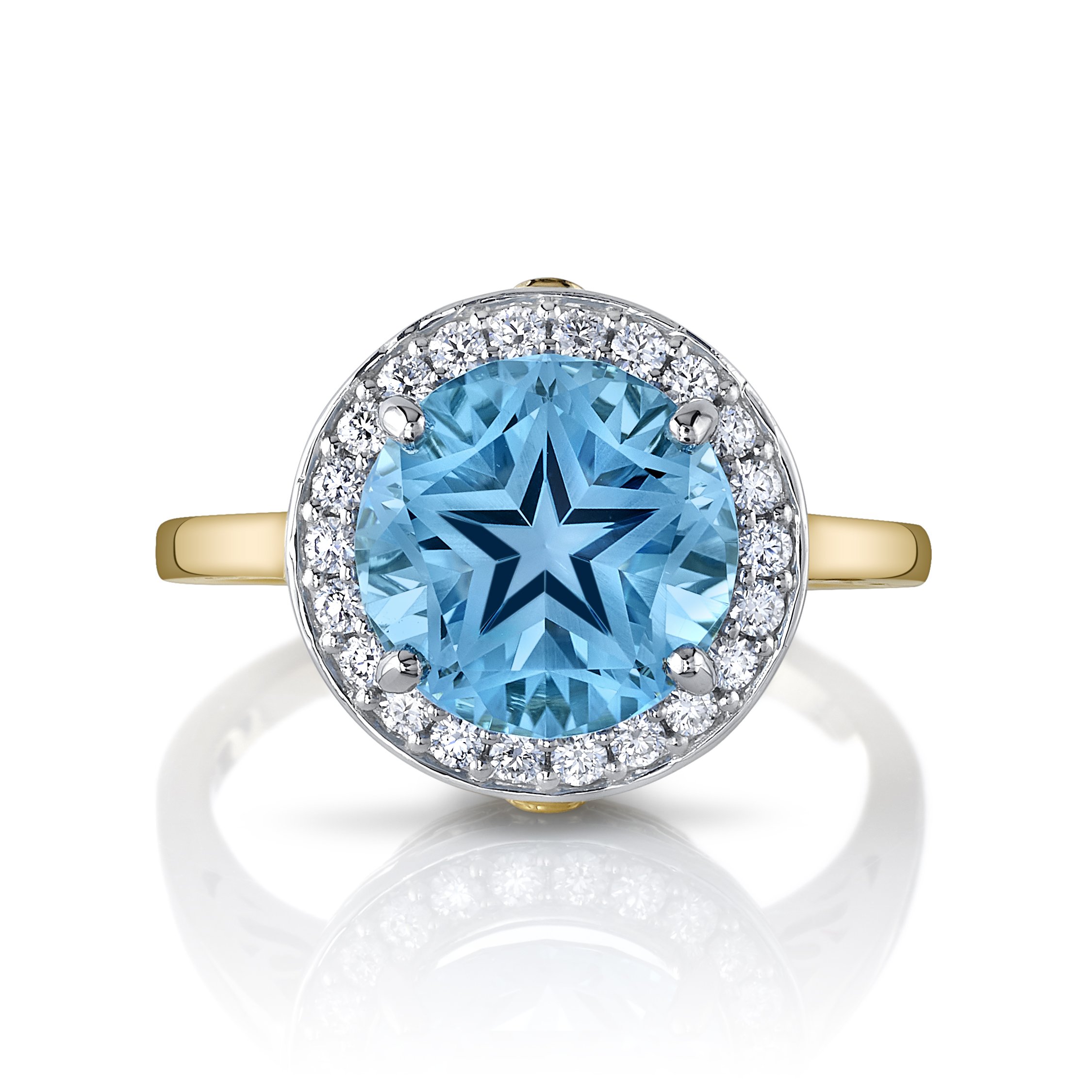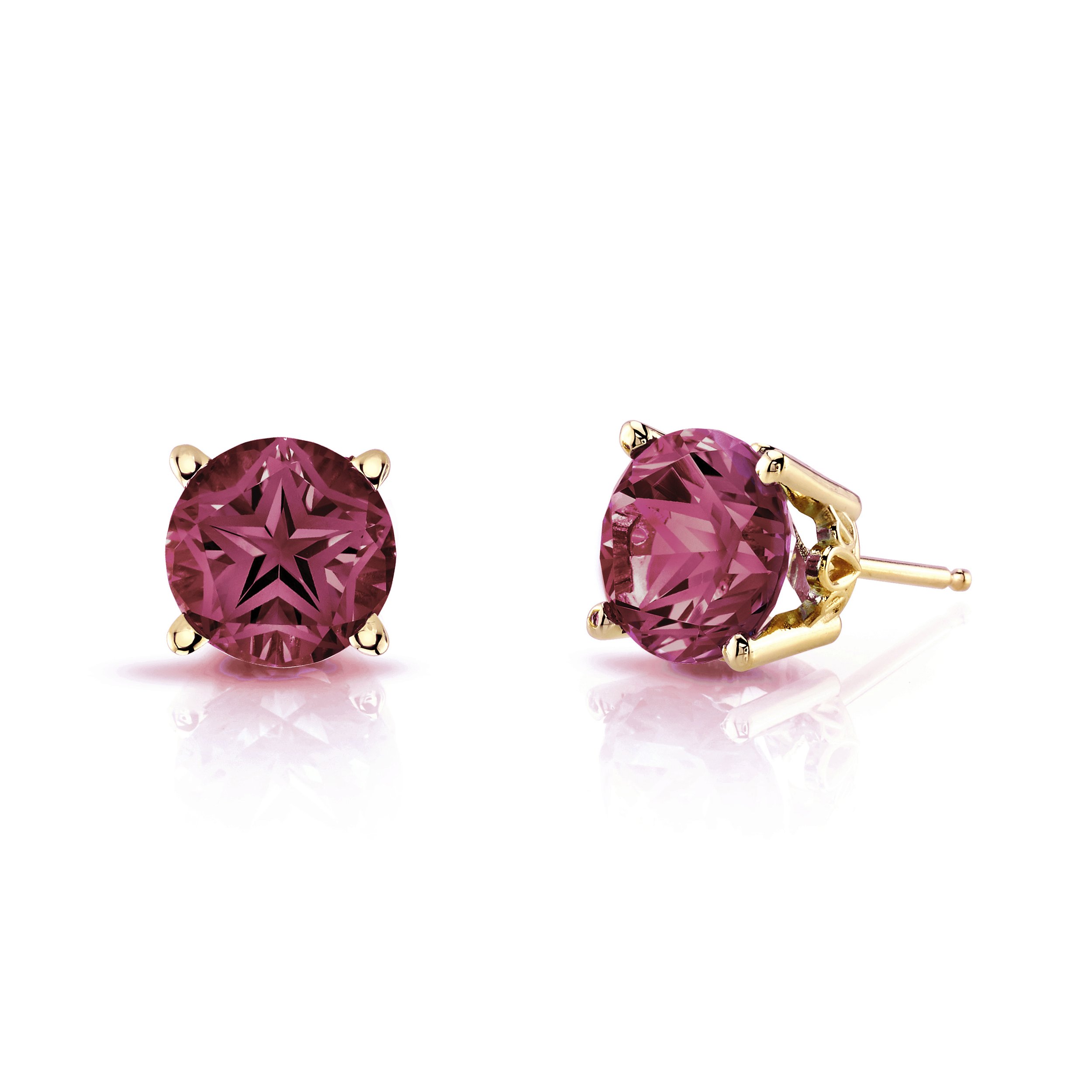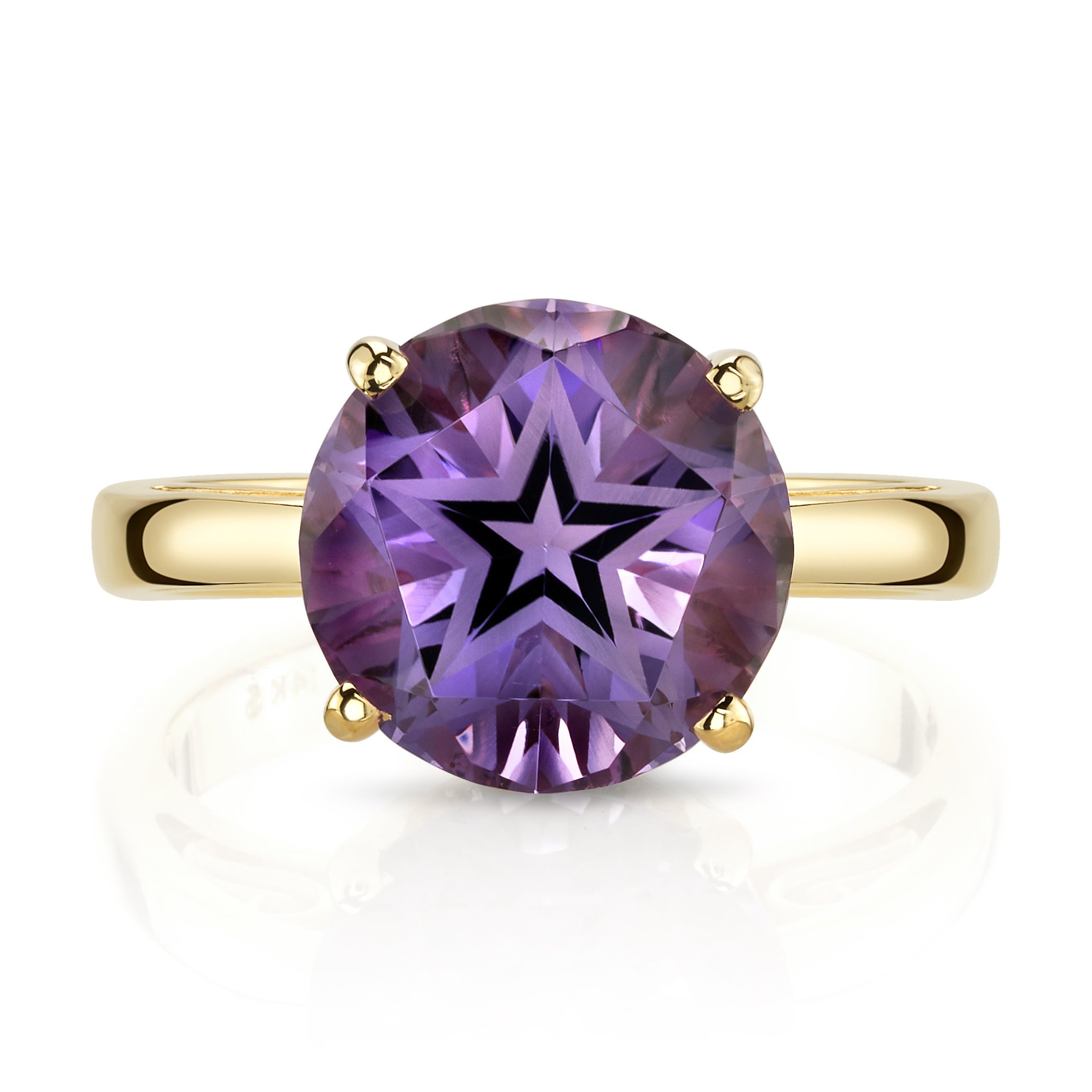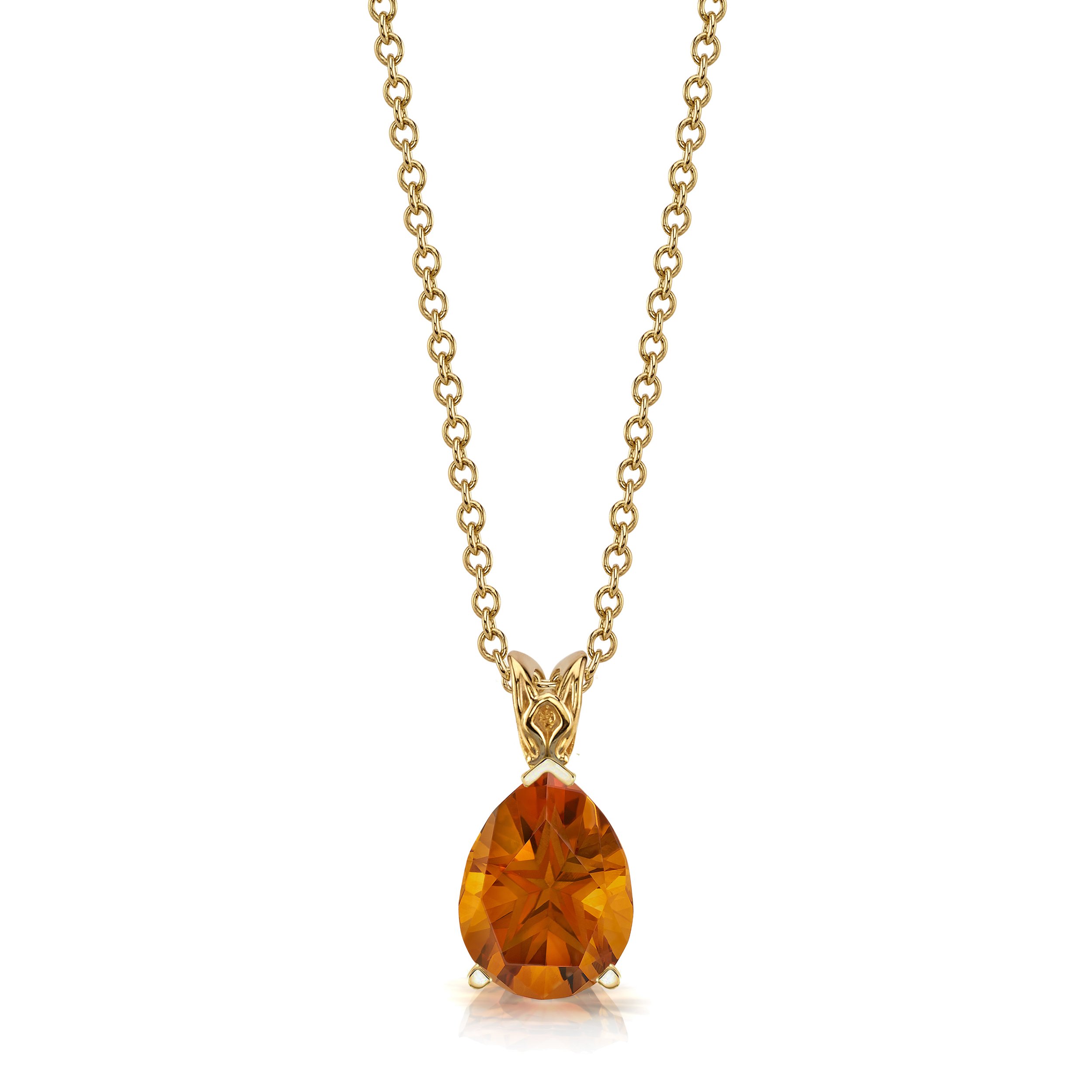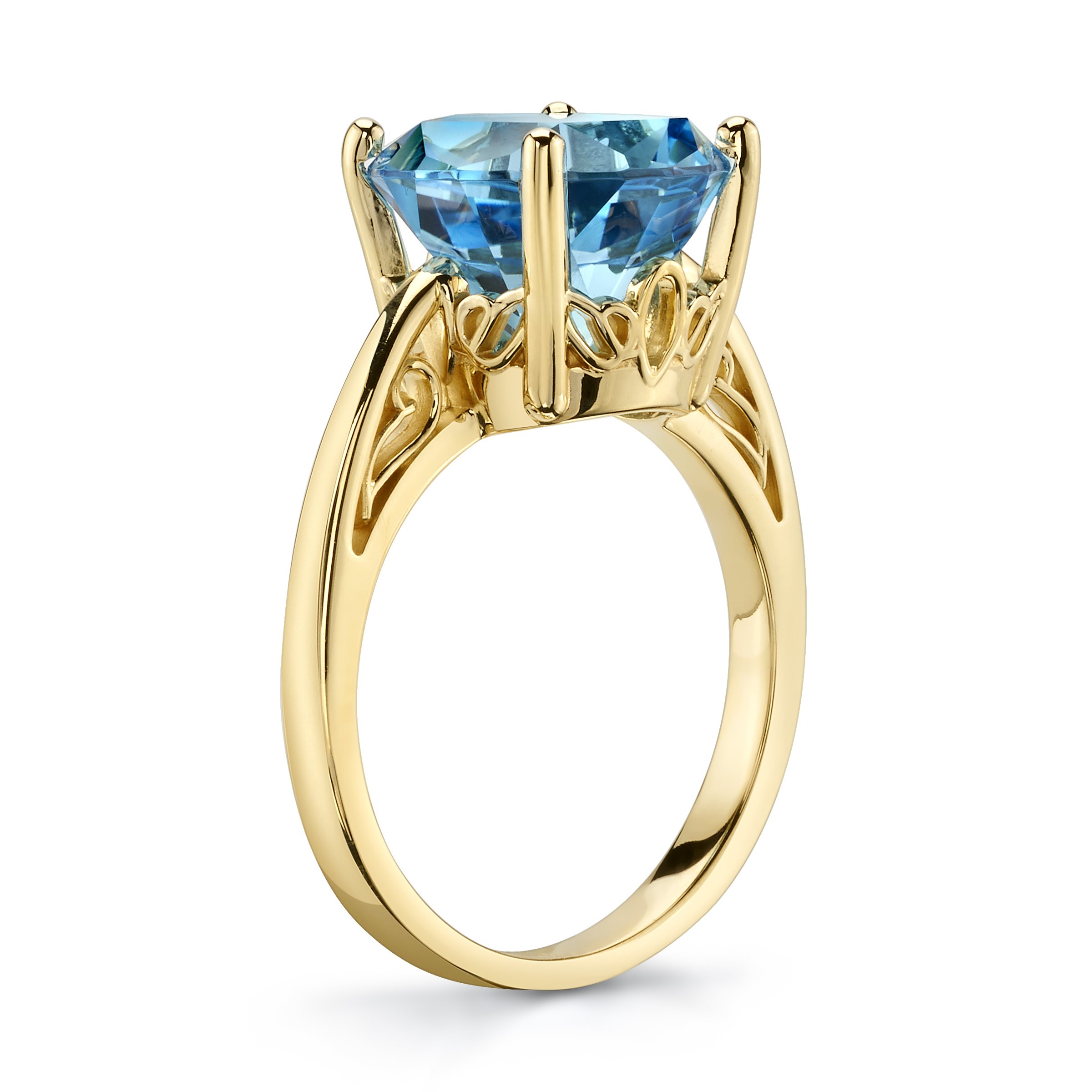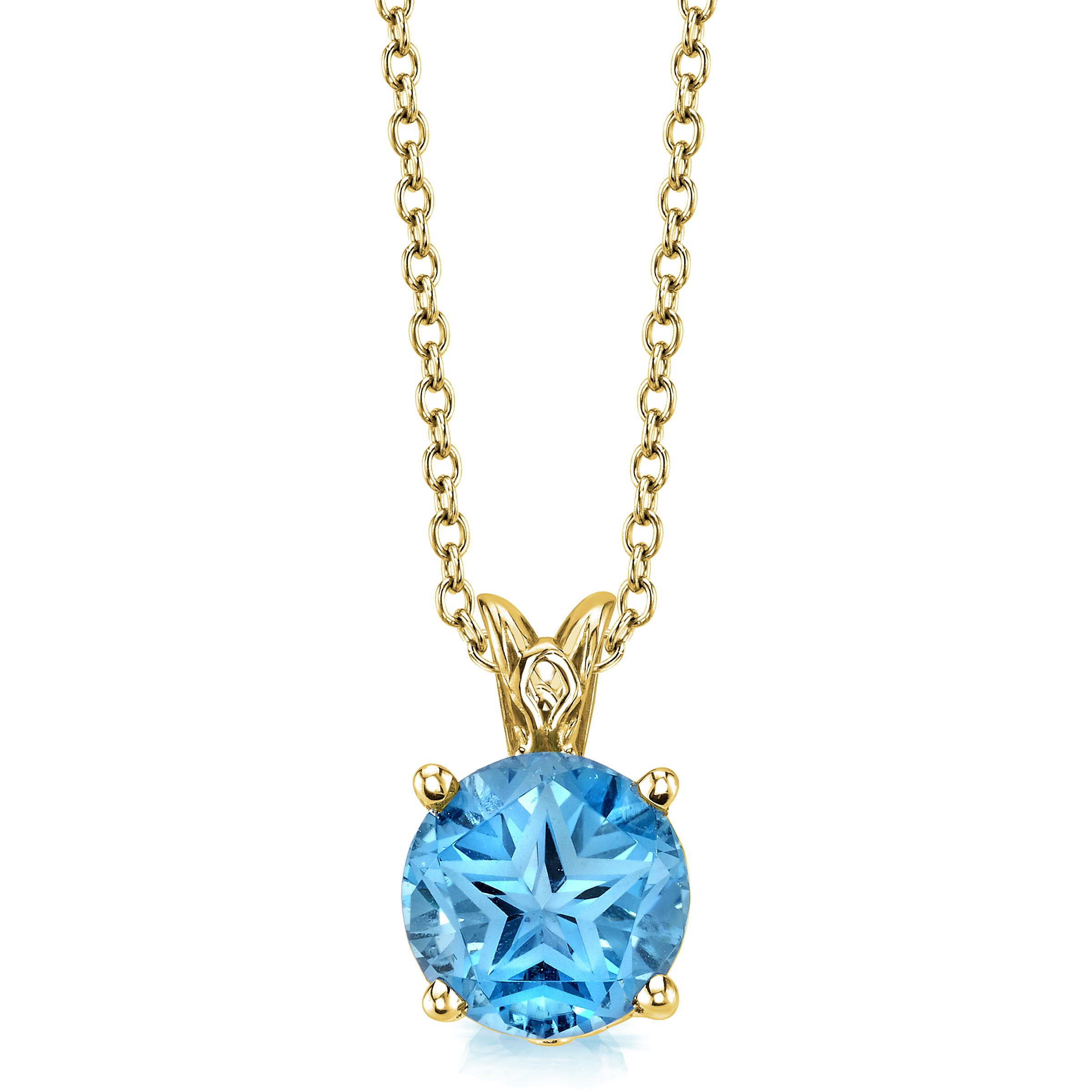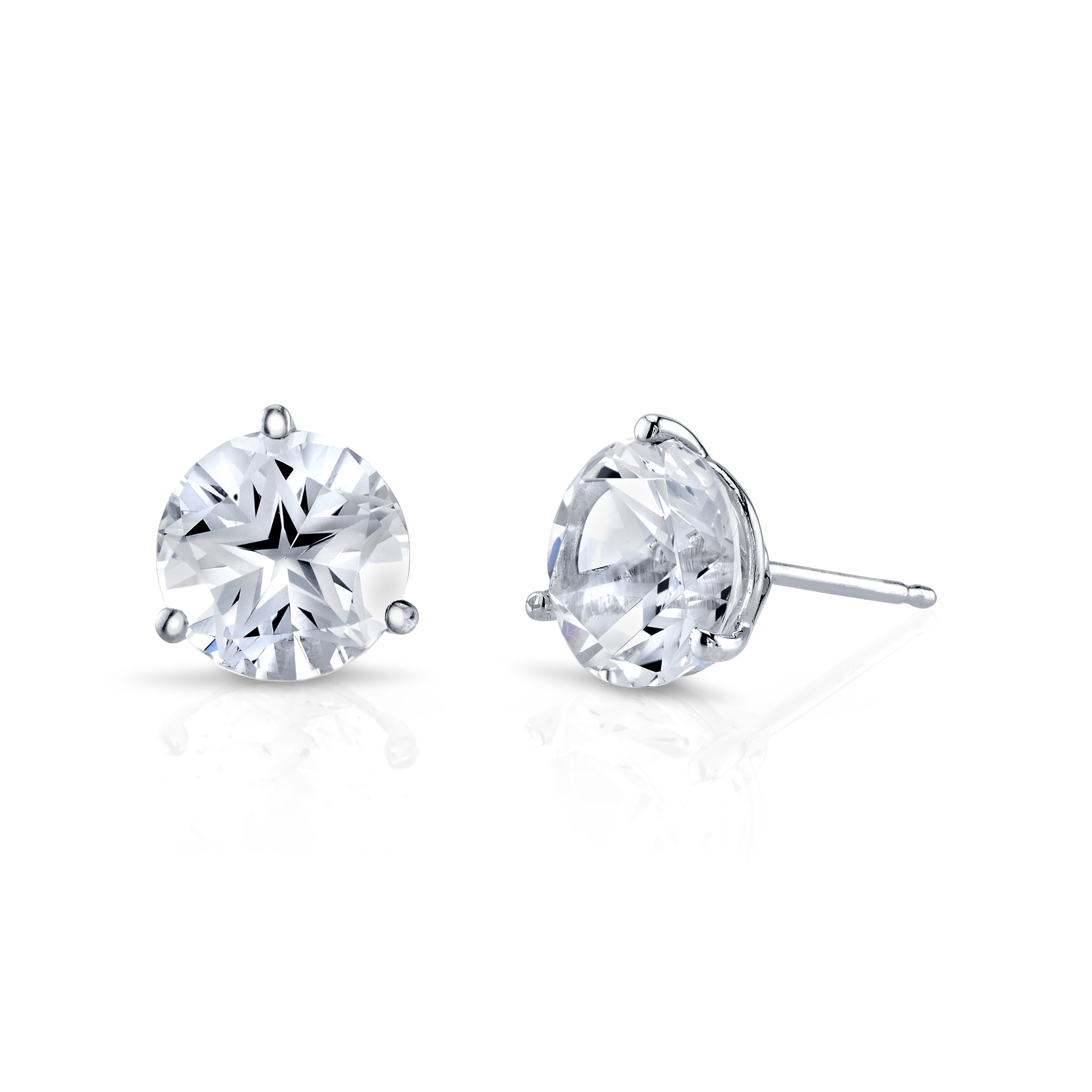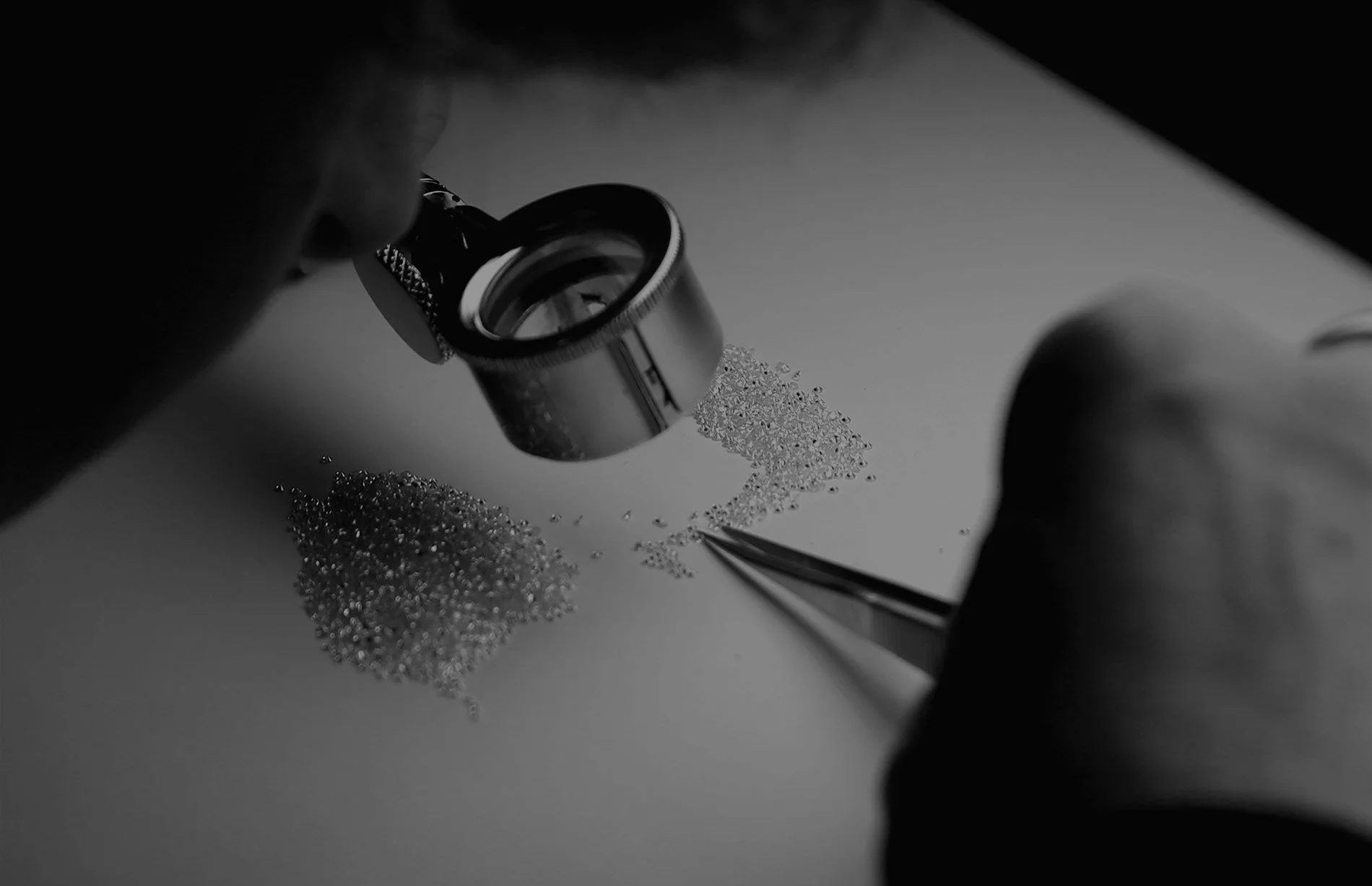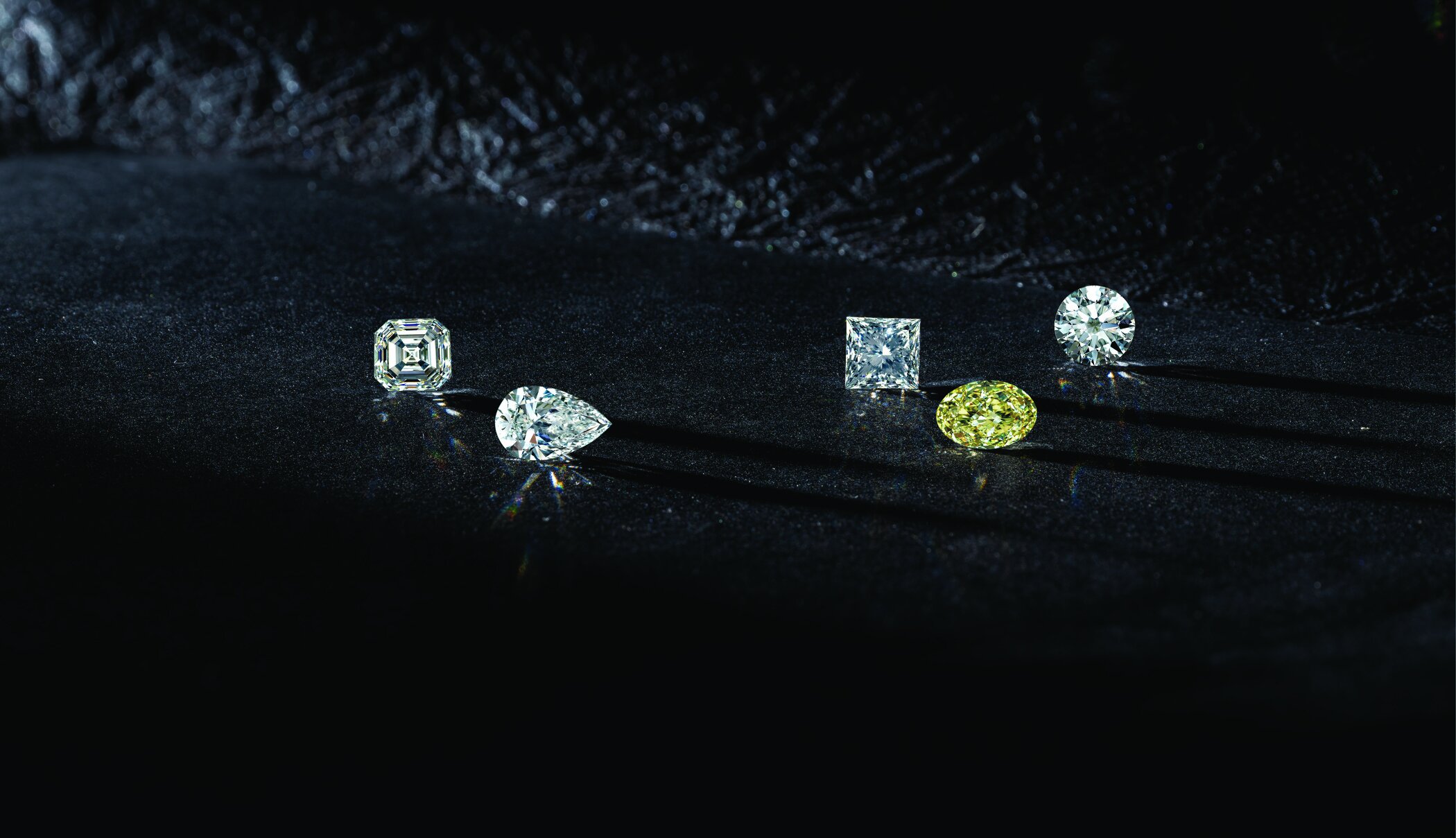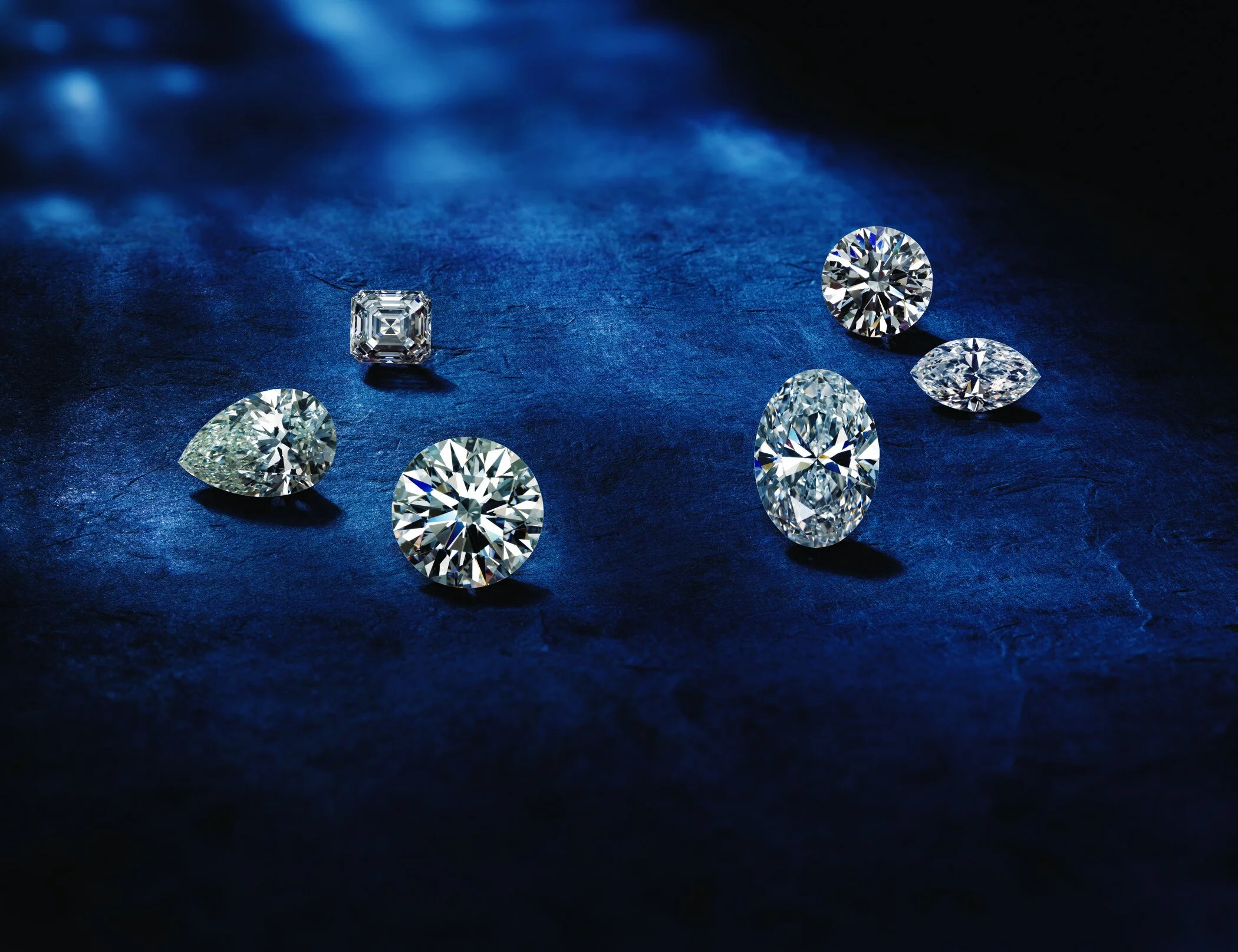Why Diamond Cut Makes the Difference: The Case for Ideal Cut Melee with Hearts and Arrows
When it comes to fine jewelry, every detail matters. Most people focus on the center stone, but what often goes unnoticed is the smaller accent stones—known as melee—that surround or complement the main diamond. These tiny stones may be small in size, but they have a huge impact on the overall brilliance and beauty of your jewelry. That’s why at Form To Feeling, we exclusively use ideal cut melee diamonds with Hearts and Arrows precision from Grunberger Diamonds—a standard far above the norm.
The Hidden Power of Melee
Melee diamonds typically measure between 0.70mm and 2.5mm in diameter. They are used to create halos, pavé settings, and other design elements that enhance the main gemstone. In most jewelry on the market, these melee diamonds are “good” cut quality—meaning they’re not optimized for light performance. They serve their purpose, but they don’t contribute much brilliance.
The difference becomes clear when you compare them to perfectly calibrated, Hearts and Arrows melee diamonds. These diamonds are precision-cut to exact proportions, maximizing light return, symmetry, and fire. Simply put, they sparkle more—and do so consistently.
Why Cut Matters More Than Carat
While color and clarity are important, cut is the most critical factor in determining a diamond’s beauty. This is especially true for melee, where minor flaws in cut quality can go unnoticed by the untrained eye, but still rob the jewelry of life and brilliance.
Standard melee diamonds are often cut for yield, not performance. In contrast, ideal cut melee diamonds from Grunberger Diamonds are cut with the same precision and care as top-tier center stones. Each one exhibits the coveted Hearts and Arrows pattern, a visual sign of near-perfect symmetry and alignment.
What Are Hearts and Arrows Diamonds?
Hearts and Arrows is a term reserved for diamonds that meet the highest standards of cut precision. When viewed through a special scope, these diamonds display a symmetrical pattern of eight hearts from the bottom and eight arrows from the top. This optical symmetry indicates exceptional craftsmanship and results in superior brilliance, fire, and scintillation.
Grunberger Diamonds is the global leader in producing Hearts and Arrows melee, and they are the only supplier trusted by Form To Feeling for these rare and refined diamonds.
Guaranteed Natural: Screened for Quality and Integrity
In an industry where lab-grown diamonds are increasingly difficult to distinguish, Grunberger Diamonds provides an extra level of assurance by screening every single melee stone to guarantee that it is 100% natural. Each diamond is meticulously tested and documented, so you can have absolute confidence in the authenticity and origin of every stone used in your jewelry. This commitment to integrity aligns perfectly with the standard of excellence we uphold at Form To Feeling.
Why We Use Grunberger Diamonds
At Form To Feeling, we specialize in bespoke fine jewelry that marries technical excellence with emotional meaning. Our clients expect the best—not just in the center stone, but in every detail. That’s why we source our melee exclusively from Grunberger Diamonds, the only company in the world offering fully calibrated ideal cut Hearts and Arrows melee.
The benefits of using Grunberger melee include:
Maximum brilliance in every facet of your jewelry
Consistent size and symmetry, critical for high-end pavé and halo settings
Unmatched craftsmanship, visible even at the smallest scale
100% natural diamonds, screened for authenticity and quality
Peace of mind, knowing your jewelry is built to the highest standards in the industry
A Difference You Can See
When you view a piece crafted with Grunberger ideal cut melee side by side with one made using standard commercial melee, the difference is obvious. The sparkle is more vibrant, the design is more refined, and the whole piece takes on an elevated, timeless quality.
For clients who appreciate the finest details—and the deeper meaning behind each piece—this is the standard you deserve.
Final Thoughts
The cut of your melee diamonds is not a minor detail—it’s a defining one. At Form To Feeling, we believe that true luxury is in the details, which is why we choose only the best. When you commission a piece from us, you’re not just getting custom design—you’re getting unmatched quality in every stone, down to the smallest diamond.
Experience the brilliance of perfectly cut, 100% natural Hearts and Arrows melee from Grunberger Diamonds — used exclusively at Form To Feeling.
Cremation Diamond Fraud: Preying on Your Grief
“There’s more to it than what meets the eye.”
We’ve all heard this saying time and time again. But would you think about this when making the purchase of your engagement ring? The ring that represents your love for one another, and the ring that you hope will last for generations to come? Unfortunately,
Introduction to Cremation or Memorial Diamonds:
The Cremation or Memorial Diamond industry began in 2002 when the process of growing diamond crystals in a laboratory environment was perfected. Using a process known as high temperature – high pressure (HPHT) method of crystal growth the conditions that exist deep inside the earth can be duplicated in a laboratory, allowing for the formation of diamond crystals, a crystallized form of pure carbon.
With the advent of this technology, companies begun to form who claimed to take carbon from the cremated ashes of deceased persons (or pets) and use that carbon to create lab grown diamonds.
However, it has always baffled me (Amy Root, Cub’s wife and by education Nurse Practitioner) that these companies could obtain enough carbon at such high temperatures, separate it from ashes and other organic matter of the deceased, to actually incorporate it into a diamond, again using high pressure and temperatures. After all, I’m sure you have all cooked charcoal on a grill and watched it turn into essentially nothing. Well charcoal is completely composed of carbon. The same element that a diamond is made of.
Over the past decade the cremation diamond market has grown to world-wide reach with companies such as LifeGem®, Lonite™, Phoenix Diamonds™, Cremation Solutions™ and Algordanza™ among the leading names; All claiming to create a piece that will “Keep their legacy alive. Turn their ashes into a cremation diamond.” But, is this actually the case or is this just a way to prey on the grieving and make more money on stones that are just lab created and likely created even before the loved ones ashes are even sent in? Cub has been keeping up with leading research so that when clients come in during their grief process, he can appropriately educate them before spending money on these stones. Additionally, I decided to try to further investigate by reaching out to cremation diamond companies to begin with. Unfortunately, none were willing to answer my questions.
Currently, the cremation diamond industry operates with no government oversight or review, and without any type of formal control regarding the claims being made regarding the actual creation of diamonds using carbon obtained from cremation ashes.
Let’s take a look at the science and newest evidence gathered by Robert James FGA, GG
Global Claims Associates Independent Insurance Adjusters and SIU Investigations
Texas Department of Insurance Property and Casualty Adjuster License #1300433
Image courtesy of GIA
What is a diamond?
Diamonds are pure, crystallized carbon. While they may be in crystal form, they contain the same ingredient as graphite or charcoal: Carbon. Now let’s dig a little deeper.
How do diamonds form?
Natural Formation
More than a billion years ago, 100 miles (161 km) or more beneath the earth’s surface, in a cauldron of extreme temperatures and high pressure, carbon atoms bonded tightly together. At temperatures higher than 2100°F (1150°C) and pressures 45,000 times greater than at sea level, crystals formed, resulting in the hardest natural mineral on Earth: diamond.
Diamonds remained hidden deep within the earth for hundreds of millions of years, until volcanic activity violently transported them upwards towards the earth’s surface in magma. Vertical rock formations, called “kimberlite pipes,” are remnants of these ancient volcanoes. Over time, erosion frees some of these rough diamonds from their host rock. Transported by rivers and streams, these diamond crystals end up in river gravel beds and silt often at great distances from their original source. Until the late 1800s, the world’s diamonds were found and collected from these alluvial beds.
Today, most diamonds are found in kimberlite pipes, which are the primary source of mined diamonds.
Lab Formation
There are two main processes used to create laboratory-grown diamonds:
1. High Pressure, High Temperature (HPHT)
With this method, laboratory-grown diamonds are produced using high-pressure, high-temperature conditions similar to what natural diamonds experience in the earth. HPHT diamond growth occurs at pressures of 5–6 GPa (roughly equivalent to the pressure exerted by a commercial jet airplane if balanced on the tip of a person’s finger) and at temperatures of 1300–1600°C. This is the process companies claim to use when creating a Cremation or Memorial Diamond.
Lower-quality diamonds, whether natural or laboratory-grown, can also be put through the HPHT process to improve color. In addition to making diamonds more colorless, this process can also be used to change the color of diamonds to pink, blue or yellow. The diamond would then be called a “treated” diamond. This is disclosed in GIA reports.
What is cremation?
Cremation is the process of reducing a dead body to mostly tiny bits of bone resembling ash that involves exposing the body to flame and intense heat followed by pulverization of bone fragments. - Merriam Webster
How hot is a cremation furnace?
Cremation furnaces operate in a temperature range of 1600F to 1800F, to insure a complete cremation of all aspects of the human body. The result is a complete burn out of any element with a burn temperature below 1600°F, including carbon, which burns at a temperature of 1200-1400°F.
Did you catch that?
Yes, cremation furnaces operate at a temperature so high that there is ZERO carbon left from the body. The cremation process destroys all traces of organic, carbon-based matter, leaving no residual carbon with which to create a diamond. Correct - There is no carbon left in the cremation ashes to make a diamond, a fact that renders all cremation diamonds as impossible to create. However, the most disturbing part of this is that these companies are aware of this and actually recommend “partial cremation” to leave carbon behind or adding carbon to the ashes. This is something no cremation company will actually do.
Preying on the grieving…
The following quotes are taken directly from the patents of LifeGem owners, and demonstrates LifeGem’s awareness that there is not enough carbon in cremated ashes to create a diamond. Quotes from the Patent are in bold.
“…. conventional cremation eliminates most of the native carbon,….” LifeGem
LifeGem admits that the cremation process eliminates carbon. They offer two methods to maintain carbon. The first is partial cremation:
“The preferred process for collection begins with the oven operator positioning the body in the oven so that the head and chest area are not positioned directly underneath the main burner.” LifeGem
LifeGem suggests the body not be totally cremated. They state further:
“Positioning the body in this manner assures that carbon will remain in the body’s head area. The carbon can then be gathered by hand, or by using a metal shovel or scoop, or the like.” LifeGem
Further, they blatantly recommend that only certain body parts be cremated:
“Alternatively, one or more body parts may be cremated.” LifeGem
There can be little doubt that LifeGem is aware that the cremation process does not leave enough carbon to create a diamond, otherwise they would not be recommending such drastic measures such as only cremating certain body parts, and/or moving the head from over the furnace and retrieving it afterwards with a shovel.
The other alternative is simple: If there is no carbon, use carbon from outside sources to make the memorial diamond:
…the remains can be cremated conventionally, mixed with additional carbon from another source, and purified as described above. It is contemplated that, using this technique, a gem containing at least some of the original carbon from the cremated remains can be prepared, even if the amount of carbon present in the remains alone is insufficient to make a gemstone of desired size or type.” LifeGem
Based on this, LifeGem, and most likely all cremation diamond companies, fully realize that carbon is lost during the cremation process, and that outside carbon must be added to the ashes before any effort to create a diamond could be successful.
The important issue in the above statement from LifeGem is that they “contemplate” or think there is “at least some of the original carbon” is included in the diamond. They think.
Simply stated: LifeGem cannot guarantee that ANY carbon from the deceased loved one’s body is included in their cremation diamonds.
What is the cost of a Cremation Diamond vs. Lab Grown Diamond?
For this comparison Robert James, GG used an average clarity and color for colorless diamonds. The company offering open-market, lab-created diamonds is Brilliant Earth. These prices are typically higher than pricing you will find with Form To Feeling, so keep that in mind when looking at these margins. Please keep in mind that these are all LAB created diamonds of comparable sizes and qualities, the only difference is a false guarantee of cremation diamonds being composed of a loved one’s ashes.
.30ct Round Colorless Diamond Average VS/G
Brilliant Earth Created Diamond: $445.00
LifeGem Cremation Diamond: $4,499.00
Eterneva Cremation Diamond: $4,499.00
Lonite Cremation Diamond: $3,400.00
.50ct round colorless diamond Average VS/G
Brilliant Earth Created Diamond: $850.00
LifeGem Cremation Diamond: $7,899.00
Heart in Diamond Cremation Diamond: $5,995.00
Phoenix Cremation Diamond: $8,695.00
Lonite Cremation Diamond: $5,300.00
.70ct round colorless diamond Average VS/G
Brilliant Earth Created Diamond: $1,440.00
LifeGem Cremation Diamond: $13,199.00
Eterneva Cremation Diamond: $13,199.00
Lonite Cremation Diamond: $9,100.00
So what’s the cost of grief?
On average, cremation diamonds cost up to TEN TIMES more than the price of an open-sourced, lab-created diamond of the same size, quality, color and cut. These numbers even blew our minds at Form To Feeling. To us, this is truly a predatory marketing strategy with pricing that is unconscionable.
What now?
Well, first and foremost. Please reach out to us to consult about a cremation diamond before you purchase it. We strongly advise not purchasing a cremation or memorial diamond. There are so many other ways to commemorate a loved one that has been lost and we are honored when clients come to us to help with these types of projects. There are even ways we can incorporate ashes into a piece without losing your loved ones ashes at all.
Secondly, the funeral homes that advertise these diamonds and push people in their immediate grief to create these lab grown stones should be held just as responsible as these companies “creating” these stones. The reality is, the funeral homes know more than any of us about the cremation process and therefore, should know it is impossible to source enough carbon from the deceased to actually create a diamond from their ashes.
Integrity: The quality of being honest, trustworthy and upright.
One of the core values at Form To Feeling is integrity. We are saddened by the lack of integrity that has infiltrated the jewelry industry over the years and we have seen dishonest practices time and time again when clients come in and have been deceived. It is heartbreaking for us to deliver this news after the process has already taken place for most of our clients. At Form To Feeling, we strive to build relationships that on trust. We will always treat you with respect, and never take advantage of you. After all, you are the reason we exist and we could not be more thankful for your loyalty.
All Fine Jewelry Is Not Created Equal
“There’s more to it than what meets the eye.”
We’ve all heard this saying time and time again. But would you think about this when making the purchase of your engagement ring? The ring that represents your love for one another, and the ring that you hope will last for generations to come? Unfortunately,
“There’s more to it than what meets the eye.”
We’ve all heard this saying time and time again. But would you think about this when making the purchase of your engagement ring? The ring that represents your love for one another, and the ring that you hope will last for generations to come? Unfortunately, Cub has had many clients come in for an appraisal on a piece purchased from a local retail store, or even a “custom jeweler” in town and they leave disappointed after seeing photos under the microscope that reveal defects and poor craftsmanship. Not to mention an appraisal far under what their purchase price was. That’s not to say this is always the case, but this is why it is so important to make informed decisions when purchasing your engagement ring, or any piece of fine jewelry for that matter.
At Form To Feeling, you will work solely with Cub Root, GIA Graduate Gemologist and AGS Certified Gemologist to ensure your piece will last for generations to come, and quite frankly - to ensure you are not getting ripped off.
So today, let’s talk about the factors that you might discuss with Cub when you come in for your custom design consultation.
What is Porosity?
Think of porosity in terms of how holey is your ring? Think swiss cheese compared to solid metal. In cast jewelry, porosity weakens the basic structure of the piece, causing ring shanks to break, prongs to break off, and galleries to crack. Even looking at a ring as close up as you can with your naked eye, you would never be able to see the porosity of a ring. Cub has a microscope in his office that he examines every single piece with. When we create a piece at Form To Feeling, we ensure there are no defects to your piece, so that it truly will last a lifetime and beyond. We will even go so far to say that if your piece does not last, due to manufacturing defect, we will always take it back and completely remake it.
Unfortunately when you go to a large chain retailer, or purchase a ring that has been mass produced, there is no guarantee the piece you are purchasing is of a quality that will last even 5-10 years before it breaks down. Unless you bring along your microscope, you may be left with a piece that will snap in half the second it is manipulated for resizing or adjustments in the future. And yes, we have seen a ring purchased brand new from a large local retailer that literally snapped in half due to the excessive porosity.
Diamond Melee Quality. Does it really matter?
Well first, what is Diamond Melee?
The easiest way to explain it is the teeny tiny little diamonds that go anywhere in a piece of jewelry. On an engagement ring, these are typically on the shank, halo, or prongs of the ring.
At Form To Feeling we use only Grunberger Precision Cut® diamonds that are calibrated within 0.00250 of a millimeter, ensuring that they will match and fit the settings we design perfectly, while being the most beautiful choice, cut to perfection. When diamond melee are not precise or top quality, the piece can look dull, dingy, lifeless, uneven and messy. Which completely defeats the purpose of using diamonds. We aren't about that dull, dingy life. Especially when it comes to your ring.
Brightness, fire and scintillation? Come again?
You want your diamond to sparkle, right? Well, when you say sparkle, Cub Root, Graduate Gemologist, thinks brightness, fire and scintillation.
Brightness is the internal and external white light reflected from a diamond, fire is the scattering of white light into all the colors of the rainbow, and scintillation is the amount of sparkle a diamond produces, and the pattern of light and dark areas caused by reflections within the diamond.
We often think of a diamond’s cut as shape (round, heart, oval, marquise, pear), but what diamond cut actually means is how well a diamond’s facets interact with light. Diamonds are renowned for their ability to transmit light and sparkle so intensely. However, with a poor cut, your diamond will lack the sparkle you’re going for. Precise artistry and workmanship are required to fashion a stone so its proportions, symmetry and polish deliver the magnificent return of light only possible in a diamond.
At Form To Feeling, we only choose the best diamonds and you are always involved in viewing all options available to you before making a diamond purchase.
“It’s simple. My goal is to create one of the most rewarding experiences imaginable. I give my time and attention to each client individually to truly understand their wants in order to excel at delivering the highest possible quality jewelry and service. Because my purpose is to give physical form to the emotions and feelings you have for one another.”
Ask the Gemologist with Brides of Austin
One of the many benefits of choosing Form To Feeling to help you with your jewelry needs, is that you have full access to Cub Root, GIA Graduate Gemologist and AGS Certified Gemologist. Cub thoroughly enjoys educating his clients…
You asked, we answered!
One of the many benefits of choosing Form To Feeling to help you with your jewelry needs, is that you have full access to Cub Root, GIA Graduate Gemologist and AGS Certified Gemologist. Cub thoroughly enjoys educating his clients and walking them through every step of the process. I have always told Cub he’s a terrible sales person, and the reality is, that could not be more true. Cub believes that educating and taking care of his clients results in success and relationships that last a lifetime. So that is just what he does. He will never try to upsell or make a quick sale because he values you and wants you to love your piece for generations to come.
Today, Cub had a chance to sit down with Brides of Austin and answer some of your most asked questions. He is passionate about the industry and absolutely loved this feature.
What colored gemstones have been trending in your jewelry making?
“While I wouldn’t say that any one particular gemstone has been trending, in the designs I’ve been doing or from what I’ve been seeing I would definitely say that garnet has been very popular. Spinel has been very popular. Both of them in a very large variety of colors. Garnet can come in red, purple, green, orange and every part of the spectrum in between those. Spinel can come in red, purples, even really low saturated colors like lavender, grey, those sort of thing. Those colors have been very popular.”
What are the colors diamonds come in?
“Believe it or not, diamonds come in just about every color. The color in diamonds is caused by trace elements within the atomic structure of the diamond itself. Some of the colors you might see, yellow for instance, is caused by there being nitrogen in the diamond. Believe it or not, some colorless diamonds as you go down the color grading scale have aspects of yellow in them. Some of the more rare colors are pinks and blue as well. Some of the rarest colors are red, orange and purple. A lot of those are very valuable, but diamonds do come in just about every color of the rainbow.”
What is the most unique piece of jewelry you’ve created?
“The first piece comes to mind due to the uniqueness of it – which comes from the story behind it. There’s a piece where the parents came to me wanting to create a piece to remember their daughter by, and so we created a beautiful ring using a really fine sapphire center stone with diamonds that set all the way around the ring. We even set a little emerald inside the ring, but every single part of the ring symbolized part of their daughter’s life.”
“The second one was just a really cool set of rings we made for a client who was actually a fighter jet pilot in the marine corp who was able to get his hands on a rear stabilizer bolt from his airplane that he flies, he gave that to us and from it, we were able to mill an entire set of wedding bands for him.”
What gemstones make for the best bespoke heirloom?
“So for this question we need to look at what’s been popular historically. If you want to create a piece that will be in your family for generations, that’s going to be passed down, really your main – three, rubies, emeralds and sapphires – are going to be really good gems to use for an heirloom piece. The lore behind some of those gems is really cool, as well. Those three have definitely withstood the test of time, so if I were going to bet on what would still be popular decades from now, those three would be at the top of the list.”
Are your diamonds and gemstones ethically or sustainably sourced?
“This is something that’s really important to me. I only work with suppliers of diamonds and colored gemstones who are extremely transparent with me, who actually see first hand every step of the process that the diamond or gemstone might take from mine to market and in doing this and knowing this pathway, we can guarantee that any diamond of colored gemstone that is sold at Form To Feeling has really benefited local populations and everyone in every step of the process.”
How customizable is the creation process with Form to Feeling?
“So the simple answer for this question is very customizable. In general my clients will have nothing but an idea, and so we work with that to go from the idea to an actual finished piece. There’s really no project as far as level of difficulty or intricacy that I say no to, with the capability to create and use whatever materials the client might want.”
For a deeper look at the custom design process, check out our custom design blog post.
A Closer Look at The Custom Design Process
Dive into the custom design process from start to finish with Cub Root at Form To Feeling.
HOW IT ALL BEGINS
When you book an appointment with Form To Feeling for a Custom Design Consultation, you will meet with Cub Root in our Austin office, virtually, or in the comfort of your own home or office. The reason Cub has chosen this business model, is to ensure you are given his full attention while working together to create your one-of-a-kind piece.
Your custom design piece starts as an idea, whether that is in your head, on your Pinterest board, from our Portfolio, or from a conversation between you and Cub. There are many times clients are unsure of what they want at all, and Cub is able to ask questions about special moments, significant items, dates, etc., and come up with an idea.
If you have a specific stone in mind for your custom design, that information is something Cub will use to incorporate into the piece. He has incredible connections in the industry, giving him access to stones that traditional jewelry storefront, third party retail stores, and online sellers, do not have access to. This is one of the benefits of working with a Private Jeweler who is a GIA Graduate Gemologist and the AGS Guild President.
Incredibly unique kite shaped diamond hand selected by Cub Root with Form To Feeling in Austin, TX.
CREATING AND EDITING YOUR DESIGN
Next, Cub creates a sketch that can be edited and tweaked to be absolutely perfect for you. Cub is meticulous with this and typically spends hours drawing this design. He will create as many different designs as you would like to compare and he will edited it 100 times, if that is what it takes to make sure you are completely blown away by the final sketch. Your jewelry is a representation of the most special times of your life. This fact is not lost at Form To Feeling. The design of your new piece of jewelry is carefully executed to capture and display the love and beauty within your relationship. Incredible attention to detail is what sets us apart from other jewelry stores, it doesn’t matter if your budget is $1000 or $10,000,000. After all, small details sometimes make the most significant difference.
Custom design sketch by Cub Root with Form To Feeling in Austin, TX.
CAD - COMPUTER AIDED DESIGN
CAD is an acronym for Computer Aided Design. It is a design that occurs in a program on a computer, where we can create three-dimensional objects in the virtual world. CAD programs are used in many industries, including jewelry! Prior to CAD all renderings were created using wax blocks and carving out the piece. While this may be a super cool way of creating a piece, it does not ensure attention to detail on a micron level. CAD allows for a lot of manipulation and almost infinite detail to create a piece that will be the exact dimensions and specifications you want. Cub creates all of his own CAD designs, something unique to Form To Feeling. This ensures that every detail communicated with Cub in your design appointment is accurately portrayed in your design.
CREATING A COMPUTER GENERATED MODEL
This is when you get to see what your piece will look like in real life, or as close to it as it gets before actually creating the piece. Sketches, and CAD images are great and truly necessary pieces of the process, but the 3D CAD image allows us to make images of pieces that don’t exist yet, creating an added value for you - our clients. It allows you to see what your design will look like when it is complete. Cub is even able to create an image with a rendering that looks similar to your hand with the ring on your finger (down to the color of your nail polish!). If there are any touch ups that need to be made, this is when you and Cub will go over those and make sure the piece is everything you’ve ever dreamed of. Your design is 3D printed at the highest resolution for casting and cast without porosity, something that is overlooked or hidden by a typical jewelry store. Even the accent gems used are all matched perfectly for cut and color, and the diamonds are cut to perfect ideal proportions, even down to 0.80mm in diameter. We are committed to perfection.
LET THE CRAFTING BEGIN
The attitude towards finishing your jewelry is no different than the initial steps. It is during this step that we have the opportunity to give your jewelry the care and attention it needs in order to last a lifetime. Using only the absolute best in the industry, Cub now turns the project over to our Master Jeweler who sits down and using the perfect marriage of modern and traditional techniques, brings all of the pieces together to create your finished piece. For over 15 years, our Master Jeweler has amazed us with his attention to detail, and unmatched craftsmanship. My favorite corny joke is that our Master Jeweler is a true gem 😉. But I mean it! He makes miracles happen, and when clients bring in pieces that were not created by our Master Jeweler, it’s obvious. He is an artist and one-of-a-kind in the industry. We are incredibly lucky to have him. His attention to detail and unmatched craftsmanship is what we are all about at Form To Feeling. We want to make sure your piece is the absolute best and will last for generations to come.
FINAL TOUCHES AND PROFESSIONAL PHOTOS
We try our best to get professional images for each and every piece we create, but unfortunately many times, the timing does not always work in our favor. If professional photos of your piece are something you would treasure, we are more than happy to get photos at any point after delivery as a complimentary service. We are so proud of the pieces we create and want you to be just as proud. We honor the quality of your piece for its lifetime and would love if you come in for cleanings and check-ups over the years.
Photo by White Pig Studio
DELIVERY FOR YOUR BIG DAY
At Form To Feeling we will go above and beyond to make sure the process and your big day is everything you’ve ever dreamed of. We have even had a “re-proposal” in our office after recreating an engagement ring for a client! Even Cub shed a tear!
This particular custom design was for a client in Houston, and the piece was hand delivered during hurricane season for the engagement to help keep it a complete surprise. Cub did not drive a boat, but he would have if that meant getting the piece to the client on time.
Engagement ring and wedding bands in their cozy new home. Photography by Dreamy Elk LLC.
ARE YOU READY TO GET STARTED?
Cub can help you create the piece you’ve always dreamed of in an environment free from pushy sales people. He has extensive experience and knowledge in creating unique, entirely custom-designed jewelry using the highest quality materials possible. If you seek something one of a kind, we have the resources to bring your ideas to life, no matter your budget.
How Form To Feeling Came To Life
In September of 2013, Cub’s dad, Kirk, informed Cub that he was very sick and that there would be many changes in the coming year. Kirk was very optimistic with his diagnosis of Stage IV Liver Cancer, but was also practical in his preparations for his family. The fate of his dad’s business, C. Kirk Root Designs was unknown, and Cub’s future was unknown. After Cub had the chance to discuss the future with his dad…
In September of 2013, Cub’s dad, Kirk, informed Cub that he was very sick and that there would be many changes in the coming year. Kirk was very optimistic with his diagnosis of Stage IV Liver Cancer, but was also practical in his preparations for his family. The fate of his dad’s business, C. Kirk Root Designs was unknown, and Cub’s future was unknown. After Cub had the chance to discuss the future with his dad, Cub decided to take a year away from his traditional studies at Texas Tech University’s Rawls College of Business, and go to the Gemological Institute of America in Carlsbad, California to obtain his Gemology diploma along with his Graduate Pearls and Accredited Jewelry Professional Diplomas. Cub thoroughly enjoyed his time at GIA, made some incredible connections in the industry, and fell in love with Gemstones and Jewelry even more.
Gemological Institute of America in Carlsbad, CA. Image Courtesy of GIA.
After a very rapid decline and hard fought battle, Kirk passed away in January of 2014. He did not get to see Cub off to his studies, see him complete his degrees that year, or see him marry Amy, but we know he would be so proud of all of Cub’s accomplishments. After Cub completed his education in Carlsbad, and married his wife, Amy, they moved back to Lubbock for Cub to finish his Business degrees in Marketing and Management from Texas Tech, where he graduated in August of 2016.
Cub and Amy are both Texas Tech Alumni, and she forced him to take this photo :)
While Cub was away at school in Carlsbad and in Lubbock, the retail front of C. Kirk Root Designs was open, but unfortunately, under poor leadership and management with many ethical concerns that, once discovered, were completely unacceptable to the Root family and left many upset customers and vendors. In 2016 when Kirk’s most trusted manager, the leader of sales, and his lead designer unexpectedly left to start their own business, Kirk’s widow, Lori, made the decision to close C. Kirk Root Designs. It was an emotionally and financially draining few years for Lori, not only from losing her husband of 35 years, but due to stolen intellectual property and other misconduct that had been happening since Kirk’s passing. However, all in all, it was an experience that made the Root family stronger, and motivated Cub to keep his father’s legacy and designs alive through the Kirk Root Collection. We could not be more thankful for the remaining C. Kirk Root Designs employees that stood by our side the last year the business was open, helping to clean up the mess left behind. We are so thankful for their relationships, and they are all still close friends of ours to this day. Ben George, Kirk’s Jeweler long before his passing, is now our main Jeweler at Form To Feeling. His craftsmanship and talent are unmatched. He is a true Gem 😏.
When Cub returned to Austin at the end of 2016, he had no idea what he was coming into. He helped his mom with final necessities of closing C. Kirk Root Designs and helped the remaining employees find alternate careers. Finding himself unemployed with time to decompress, Cub got the idea of “Form To Feeling”. He had continued doing custom designs here and there while deciding what would be next, and he truly enjoyed the relationships he built and connections he made networking within the industry. During this time, he was truly giving Form to his client’s feelings. In September of 2017, Cub opened his own business, Form To Feeling or Kirk Root Designs LLC.
Form To Feeling is a business built on honesty, integrity, transparency, inclusivity, and family at the core of its values. Cub decided to pursue an appointment only business model with hopes that his business would focus on building relationships and giving clients the utmost attention they deserve. Cub’s main goal is to take care of his clients first and foremost; He believes that treating clients well, catering to their needs, and putting them first, leads to a successful business. Cub is a relationship based person, and genuinely feels he has a relationship with each of his clients. He strives to exceed expectations and create lifelong relationships that will last for generations to come.
After two years of incredible growth, Cub is now able to focus his time and attention on his clients custom design projects and custom orders while his wife, Amy, does the behind the scenes marketing, website management, and networking (hi!). Opening his own business and building his dream in the way he designed it, has been the best decision he could have ever made for our family. We have a precious daughter Abigail, who adds a cuteness factor to our Instagram and Facebook on occasion. We are expecting a little boy in March of 2021, who will be named Charlie after Cub and Kirk, both named Charles. Cuteness factor of social media will double shortly thereafter, so make sure you follow, like and share our accounts and posts. We are a word-of-mouth business, so we truly could not do it without you!
If you are a client of ours, please leave us a review and help spread the word about Form To Feeling. We love each and every one of you and could not have this business without you.
Legacy Ranch Styled Shoot
Our latest styled shoot was at Legacy Ranch in Fredericksburg, and boy was it beautiful. Not only was it a treat to get our jewels on a model and capture stunning photos, but it was also a chance…
Our latest styled shoot was at Legacy Ranch in Fredericksburg, and boy was it beautiful. Not only was it a treat to get our jewels on a model and capture stunning photos, but it was also a chance to tag along with Cub in action and get away from the hustle and bustle of Austin. The owners of the venue were so kind to have us come visit the night prior to the shoot and the views, serenity, and hospitality were unmatched! The photographer, Emily, owner of Dreamy Elk Photography LLC also stayed the night prior in a cabin on the property and took family photos for us prior to the shoot. We are due with a little boy in March, and what a better place for photos?!
Hair stylist, Sunny with Sunny Hair and Makeup, along with Fiancé Bridal Boutique Boerne, got our incredible model, Lauren, all dolled up and ready to go and the fun began! This was an incredibly efficient shoot with very efficient vendors. If you are a soon to be Bride in the Austin area, on the hunt for vendors, these are your people. Y’all, Dreamy Elk knows how to direct and capture exquisite photos flawlessly.
As for the jewelry, we brought along a few classic white diamond pieces, a unique vintage platinum and diamond Lady Elgin watch that would be your perfect “something old”, and some unique sapphire pieces for that “something blue”!
Contact us if you would like to inquire about purchasing these stunning pieces or creating a piece you’ve always dreamed of.
What Makes Texas Topaz Special?
One thing I have always loved about Texas is how unique we are compared to other states. Tacos are a staple and can be had for breakfast, lunch, dinner and even dessert, and we have what one of our best New Yorker friends calls hot dogs, for breakfast - aka kolaches. Let’s not forget the gorgeous wildflowers lining…
One thing I have always loved about Texas is how unique we are compared to other states. Tacos are a staple and can be had for breakfast, lunch, dinner and even dessert, and we have what one of our best New Yorker friends calls hot dogs, for breakfast - aka kolaches. Let’s not forget the gorgeous wildflowers lining our highways in the Springtime, making Texas the most beautiful state in the country (too biased?). And of course, we say the infamous “y’all” like it’s going out of style. Native Texans, like Cub and I, are only slightly proud of being born and raised in this great state of Texas.
Set by Texans.
A Lone Star Blue Topaz being set by Chris Root, Kirk’s oldest son, at C. Kirk Root Designs in the early 2000s.
Now, let’s talk about Texans being proud of our state. We are not the only state with our own Gemstone, but we are the only state with our own gemstone cut; The Lone Star Cut. This cut was adopted May 25, 1977 and just a few short years later, C. Kirk Root got it right. So much so that when C. Kirk Root began cutting the triple star into Texas Topaz in the 1980s, his designs and specifications were recognized and used as a reference for the Lone Star Cut being to the exact specifications required. It is important to be aware that not all Lone Star Cuts are created equal, nor are they recognized by the state as the true Lone Star Cut. To this day, our very own Lone Star Blue Topaz and Texas Topaz are start cut by our very own lapidary to our exact specifications in order to achieve the triple star you see projecting from the inside of the stone.
The Original…
One of the first Lone Star Cut Blue Topaz pieces created by C. Kirk Root and used by the State of Texas for Lone Star Cut guidelines.
So what makes Texas Topaz special? Well! It is exceedingly rare, only being found within the borders of Mason County, Texas. It is also a lot of work to find! Since commercial mining of Topaz does not exist, it is only found by a process called “Topaz Hunting”. There are a few ranches within Mason County that allow the public to hunt for Topaz and many of them have great reviews. I am determined to make this a Root Family outing one of these days, but I have a feeling our daughter, and my pregnant self, would not have the patience to last as long as we would need to in order to actually find gems.
Mason County Texas Topaz with the original Texas Lone Star Cut.
Topaz comes in many many different hues, but Blue Topaz is the birthstone for December and it is the gem of the 4th anniversary. One thing Cub and I truly love about all Gemstones that really makes us fall in love with them, is that they all have a significant meaning and story to tell. Whether it’s a personal sentimental meaning or the actual stone’s story itself, they all tell a story. When C. Kirk Root Designs was closed by Lori Root in 2017 after an emotionally draining few years, The Kirk Root Collection was born from one of these stories. We are so proud to carry on Kirk’s original designs within The Kirk Root Collection at Form To Feeling and we hope you enjoy these gorgeous pieces as much as we do. See our Bluebonnet blog post to learn about how the Wildflower Collection within The Kirk Root Collection was born.
The Story of The Original Texas Bluebonnet
Spring time in Texas brings bluebonnets, Indian paintbrushes, Indian blankets, sunflowers, and other Texas wildflowers covering the Texas roadsides and prairies. At Form To Feeling wildflowers hold a particularly special place for us…
Spring time in Texas brings bluebonnets, Indian paintbrushes, Indian blankets, sunflowers, and other Texas wildflowers covering the Texas roadsides and prairies. At Form To Feeling, wildflowers hold a particularly special place for us.
Kirk Root’s First Signature Piece
“I knew if I sold one bluebonnet per month we could pay the bills. Two, we could buy groceries. But if I sold three, I could take Lori on a nice date."
-Kirk Root, telling the story of the early days crafting The Original Texas Bluebonnet.
In 1986, the Bluebonnet Pendant became a Kirk Root signature design and a customer favorite. So much so, that it inspired him to create an entire Wildflower Collection of handmade Texas wildflower pieces. In 2016, after Kirk’s widow, Lori, closed C. Kirk Root Designs in the Arboretum, Cub wanted to make sure his father’s designs were not lost forever. Opening Form To Feeling in 2017, Cub created The Kirk Root Collection for this purpose. He has since expanded the Wildflower Collection to include the Amazing Grace Sunflower. A portion of profits from the Wildflower Collection are given back to charity organizations including the Lady Bird Johnson Wildflower Center and Brookwood in Georgetown. Cub is proud to carry on his father’s legacy as the original creator of the Texas Wildflower Collection and Lone Star Cut Topaz fine jewelry in our Kirk Root Collection.
The Story of Our Original Texas Bluebonnets
In the mid-80s, Kirk Root, Cub’s father was an up-and-coming jeweler in Texas, looking to make a name. He had already distinguished himself by becoming the youngest ever master appraiser at age 22, but as he launched his own custom jewelry store he knew that he needed a signature piece. Inspired by the springtime bluebonnets that surrounded him, Kirk set out to create a statement piece that captured not only the beauty of Texas bluebonnets, but also the sentiment that surrounds them – the springtime joy that heralds long days and warm nights of lounging at Zilker Park, cooling off in Barton Creek and chowing down on tacos. In order to capture the brilliance of the bluebonnets, Kirk opted to use diamond cut blue sapphires, green gold, and tsavorite green garnets, with diamonds running up the stem for an extra sparkle. He knew he had a hit when he finished his first prototype and laid it in the showcase, only to have his mother (our grandmother) grab it, put it on and refuse to take it off. Since then, Cub has added the Sterling Silver Bluebonnet to the collection using exquisite alternative materials in order to be available at a more modest price point. Each Sterling Silver Bluebonnet is made in Sterling Silver and hand set with created fine blue sapphire, created fine emerald, and Swarovski cubic zirconia. Every stone is hand selected to be of the highest quality in each individual piece. The yellow gold option is made in sterling silver with a yellow gold micro plating.
What Makes Our Texas Bluebonnets So Special?
Unsurprisingly, Kirk’s one-of-a-kind design has inspired many imitators and knockoffs, but no other jeweler can match the love and craftsmanship that we put into our pieces.
We hand-pick and hand-set our diamond cut blue sapphires.
No one was diamond cutting sapphires when he started making these pieces in the 80s, so each sapphire was custom cut just for these pieces.
We use tsavorite green garnet instead of emeralds because garnet is more durable and gives off a shine that truly does justice to the Texas bluebonnet.
We buy hundreds of carats of garnets and sapphires and choose only the top 10% for our wildflower pieces.
Genuine Wildflower Collection pieces will always carry the Kirk Root trademark stamp.
Forever springtime at Form To Feeling.
Thank you for reminiscing on these special pieces with us. We are happy to be able to carry on Kirk Root’s legacy through the Wildflower Collection and Texas Star Cut Gemstone pieces in The Kirk Root Collection. We know there is a piece of Texas for everyone within The Kirk Root Collection, and we hope you enjoy these pieces as much as we do. If you have any questions when ordering from The Kirk Root Collection, please let us know! To read more about Kirk’s Lone Star Cut Gemstone Collection within The Kirk Root Collection, view our blog post here.
The "Crisis In Melee"
An article put out by Rapaport this week states that melee suppliers are currently dealing with an alarming crisis. Although melee supply continues to be high, demand has declined. According to Rappaport, that is due to three factors:…
An article put out by Rapaport this week states that melee suppliers are currently dealing with an alarming crisis. Although melee supply continues to be high, demand has declined. According to Rappaport, that is due to three factors: Indian manufacturers' difficulty with obtaining funding, undisclosed synthetics within 'natural melee' supplies, and the fact that traders are allowed to order by millimeter instead of by carat.
The article states, " Some retailers are shying away from natural melee because of the threat of undisclosed synthetics. In addition, there is a small but growing preference to use better-quality lab-grown melee rather than lower-quality natural stones that cost the same."
It is important to understand why our diamonds are not susceptible to some of the issues that certain manufacturers face. With the help of the M-Screen, we ensure that all of our stones are natural polished stones. We believe the cut is the most important C of the 4C's and that is why all of our stones, including those that are 1.00 mm are proven to be AGS 0 with Hearts and Arrows in all our color and clarities from VVS to I1. A true rarity within the world of melee.
To read more regarding the article, please click here.
Image courtesy of Grunberger Diamonds, Form To Feeling’s exclusive melee supplier.
How Are Lab-grown Diamonds Created?
Lab-grown diamonds are an increasingly popular, attractively priced center stone option. In the past few years, we’ve seen a growing trend among consumers…
Lab-grown diamonds are an increasingly popular, attractively priced center stone option. In the past few years, we’ve seen a growing trend among consumers toward interest and acceptance of lab-grown diamonds.
In July 2019, MVI Marketing asked 1,154 millennial consumers aged 21–36 if they’d consider a lab-grown diamond for the center stone of their engagement ring. A whopping 67% said yes — and 21% said maybe.
Remember, your knowledge gives you the opportunity to build trust. At Form To Feeling, we want you to feel empowered through education in the industry.
So, what’s the difference between natural and lab-grown diamonds?
Diamond Types
Natural diamonds built the industry, and you can say they are pretty timeless: they formed 1.0 to 3.5 billion years ago. Their age and their unrivaled cultural symbolism — “a diamond is forever” — support their long-standing appeal.
Based on their impurities, all diamonds are divided into two types:
Type I Diamonds
Type I diamonds contain nitrogen and account for 98% of natural diamonds. According to the cluster arrangement of those nitrogen atoms, this category is further subdivided into two types: Type 1a and Type 1b.
Type 1a diamonds are plentiful, and their color varies from near-colorless to light yellow.
Type 1b diamonds are rare and typically strong yellow in color.
Type II Diamonds
Type II diamonds have no measurable level of nitrogen and account for only 2% of natural diamonds. Then, they are further subdivided. If containing boron, diamonds are Type IIb. If not, they are Type IIa.
Type IIa diamonds have no measurable levels of nitrogen or boron. They are usually colorless but also come in shades of light brown. Many of the world’s historical diamonds — like the Cullinan and the Koh-i-Noor — are type IIa.
Type IIb diamonds — unlike all other types — conduct electricity and exhibit beautiful blue or blue-gray shades due to the presence of boron. The Hope Diamond is the most famous type IIb diamond. *NOTE: Some IIb diamonds with trace amounts of boron remain colorless, yet still conduct electricity. Likewise, Moissanite is electrically conductive. Because of this, probe-type testers measuring for conductivity may falsely call out type IIb diamonds as Moissanite.
That’s quite a range for diamonds to fall into, but what about lab-grown diamonds? As it turns out, they play by slightly different rules — solely thanks to the method in which they’re grown.
Lab-Grown Diamonds
Lab-grown diamonds exhibit the same optical, physical, and chemical properties as natural diamonds. Unlike natural diamonds, which can be either type I or type II, all colorless lab-grown diamonds are type II.
While it is impossible to detect lab-grown diamonds by sight, the growing process leaves behind evidence of any diamond’s origin. Advanced screening and testing equipment is necessary here. No matter how educated your Gemologist or Jeweler is, they cannot tell the difference between lab grown and natural diamond without proper testing.
So, How Are Lab-Grown Diamonds Created?
Lab-Grown Diamonds are not simulants. Scientists create them in a lab. They start with rough crystals and are grown using either HPHT (High Pressure High Temperature) or CVD (Chemical Vapor Deposition) — sometimes both methods. Lab-Grown Diamonds can cost 30-50% less than Natural Diamonds and are chemically identical to their diamond counter parts.
Lab-grown diamonds got their start in the ‘50s with General Electric — yes, the power company. Although General Electric (specifically, H. Tracy Hall, but that’s a story for another day) pioneered lab-grown diamonds, they grew these diamonds through just one process. Today, there are two. We’ll start with the first.
Chemical Vapor Deposition (CVD)
The CVD process was invented first— in 1952 by William Eversole at Union Carbide. This process allows diamonds to grow in an entirely different way than the HPHT process. CVD starts with a natural diamond slice (or seed) placed in a chamber and exposed to less extreme temperatures (approximately 1,200–3,000 degrees Fahrenheit) and lower pressure (100 – 550 PSI).
Recent advancements have made this growth process more advantageous. Methane and hydrogen gas are injected into the chamber and combined with high heat. The electrons separate, forming plasma gas. The freed carbon then rains down on the seed, growing new diamond crystals. Typically, this process produces brown or gray diamonds, which are turned colorless through an HPHT annealing process. This process takes several days to a few weeks.
High-Pressure High-Temperature (HPHT)
The HPHT process grows diamonds using diamond presses, machines that mimic the extreme conditions that form diamonds within Earth’s upper mantle: intense pressure (725,000 – 870,000 PSI) and intense heat (2,300–2,900 degrees Fahrenheit). In this process, diamond source powder dissolves in molten metal flux and deposits on diamond seed crystals.
This process dates back to 1954. By the 1970s, General Electric started commercially producing “gem-quality” HPHT lab-grown diamonds. In the following years, General Electric and other companies grew larger sizes of non-gem-quality diamonds strictly for industrial use. Since then, HPHT technology has come a long way, now growing lab-grown diamonds for use in jewelry. This process takes several days to a few weeks.
What’s Best For You?
Well, that is for you to decide! However, we are here to provide you with education, and are even able to have lab grown and natural diamonds available for you to compare and see for yourself. So book your appointment today, and let’s get started on your project. We can’t wait to meet you!
Diamond Quality Factors
Have you ever had a diamond catch your eye from across the room because it is just THAT beautiful? Or what about the other way around, when someone has a very large diamond, but it just seems to lack the sparkle you would…
Sparkling with an internal fire all its own, diamond is one of the world’s most sought-after and adored gemstones. It is a symbol of clarity and strength. So strong, in fact, that its name comes from the Greek word "adamas," which means “invincible” or “unbreakable”. But why? Each diamond is unique and is a miracle of time, place and change. And each has specific qualities that establish its value.
Have you ever had a diamond catch your eye from across the room because it is just THAT beautiful? Or what about the other way around, when someone has a very large diamond, but it just seems to lack the sparkle you would expect from a diamond? Well! Not all diamonds are created equal, and all quality factors play into what you see with the naked eye. When you book an appointment with Cub, you will go through each of these quality factors to determine which are most important to you to help fit within your budget. From there, Cub will bring in the most appropriate diamonds for you to compare and choose from. He will do everything he possibly can to make sure you can make an informed buying decision. This is the beauty of working with Form To Feeling; We tailor your design experience to you individually to meet your needs and desires.
To learn more about Diamond Quality Factors, visit our Diamond Education page.
3ct Oval Diamond Engagement Ring by Form To Feeling
Jewelry Without Compromise
My goal in this industry is to flip the expectations when it comes to jewelry. So much information and details are purposefully or accidentally skipped over when selling jewelry. This is where my passion takes flight. I believe that jewelry is not something that…
Cub Root, C.G.,G.G.
founder, designer, gemologist
First and foremost, thank you so much for stoping by and taking the time to learn about Form To Feeling. I am so glad you are here and I cannot wait to help you make your jewelry dreams come to life. I am Cub Root, founder of Form To Feeling LLC. I studied gemology in residence at the Gemological Institute of America in Carlsbad, California where I also earned my Graduate Pearls and Accredited Jewelry Professional diplomas. I am the firm's AGS titleholder as an AGS Certified Gemologist, and a member of the Accredited Gemologists Association. I am the AGS Guild President of the Austin area and very proud to be a part of an organization with such high ethical standards. I have spent my entire life in the jewelry store gaining hands-on experience once and knowledge of the industry. And when I say that, I mean it literally; I was in my Dad’s jewelry store from the time I was born all the way until my wife and I moved away from the Austin area for a short time to complete our degrees.
I am passionate about educating clients and being transparent with the entire process of creating your one-of-a-kind piece, and not making any sacrifices to quality. My goal in this industry is to flip the expectations when it comes to jewelry. So much information and details are purposefully or accidentally skipped over when selling jewelry. This is where my passion takes flight; I believe that jewelry is not something that is just sold. Too many stores do not give it the appreciation it deserves. Jewelry is a way to celebrate important moments in life and to express yourself. Just like your relationship, you get out what you put in. This is why I only use the finest quality goods.
Before any decisions are made, I educate you to make sure you thoroughly understand the product and are confident it will genuinely embody the feelings you have. There is no detail left untouched. Even our smallest of diamonds are precision cut to have perfected proportions and light performance, all the way down to 0.6mm diameters. Your love is uncompromising, so celebrating your most precious moments should be too.
If there is one thing I leave you with before you continue browsing, it is that when I hand you your finished piece, I take pride in that piece, as it is a direct reflection of myself. I want you to love your piece for life and be able to share it for generations to come. I am thrilled that you have chosen to research Form To Feeling, and I am happy to answer any questions you may have about our process. Feel free to call, text or email me for any and all of your jewelry needs.

